EXHIBIT 99.2
Published on October 30, 2019
Exhibit 99.2
FORTIVE CORPORATION AND SUBSIDIARIES
RECONCILIATION OF GAAP TO NON-GAAP FINANCIAL MEASURES
AND OTHER INFORMATION
Adjusted Net Earnings from Continuing Operations, Adjusted Diluted Net Earnings per Share from Continuing Operations, Adjusted Revenue, Adjusted Operating Profit, Adjusted Operating Profit Margin, Adjusted Gross Profit, Adjusted Gross Profit Margin and Adjusted Effective Tax Rate
We disclose the non-GAAP measures of historical adjusted net earnings from continuing operations, historical and forecasted adjusted diluted net earnings per share from continuing operations and historical adjusted estimated effective tax rate, which to the extent applicable, make the following adjustments to GAAP net earnings, GAAP diluted net earnings per share and GAAP estimated effective tax rate:
• |
Excluding on a pretax basis amortization of acquisition-related intangible assets; |
• |
Excluding on a pretax basis acquisition and other costs deemed significant (“Transaction Costs”); |
• |
Excluding on a pretax basis the effect of deferred revenue and inventory fair value adjustments related to significant acquisitions; |
• |
Excluding on a pretax basis the effect of earnings from our equity method investments; |
• |
Excluding on a pretax basis the non-cash interest expense associated with our 0.875% convertible senior notes; |
• |
Excluding on a pretax basis the non-recurring gain on the disposition of assets; |
• |
With respect to adjusted net earnings from continuing operations and adjusted diluted net earnings per share from continuing operations, excluding on a pretax basis restructuring charges; |
• |
Excluding the tax effect of the adjustments noted above. The tax effect of such adjustments was calculated by applying our overall estimated effective tax rate to the pretax amount of each adjustment (unless the nature of the item and/or the tax jurisdiction in which the item has been recorded requires application of a specific tax rate or tax treatment, in which case the tax effect of such item is estimated by applying such specific tax rate or tax treatment). We expect to apply our overall estimated effective tax rate to each adjustment going forward, and, as such, we are applying the estimated effective tax rate to each adjustment for the forecasted periods to facilitate comparisons in future periods; |
• |
Excluding the 2017 provisional amount estimated in connection with the Tax Cut and Jobs Act and subsequent adjustments to the provisional estimates (the “TCJA Adjustments”); and |
• |
Including the impact of the assumed conversion of our Mandatory Convertible Preferred Stock. |
We also disclose non-GAAP measures of historical adjusted revenue, historical adjusted gross profit, historical adjusted gross profit margins, historical adjusted operating profit, and historical adjusted operating profit margins, which make the following adjustments to GAAP revenue, GAAP gross profit, GAAP operating profit, GAAP gross profit margin, and GAAP operating profit margin:
• |
Excluding the effect of deferred revenue fair value adjustments related to significant acquisitions; |
• |
With respect to adjusted gross profit, adjusted gross profit margins, adjusted operating profit, and adjusted operating profit margins, excluding the effect of inventory fair value adjustments related to significant acquisitions; |
• |
With respect to adjusted operating profit and adjusted operating profit margins, excluding acquisition and other costs deemed significant; and |
• |
With respect to adjusted operating profit and adjusted operating profit margins, excluding amortization of acquisition-related intangible assets. |
While we have a history of acquisition activity, we do not acquire businesses on a predictable cycle, and the amount of an acquisition’s purchase price allocated to intangible assets and related amortization term and the deferred revenue and inventory fair value adjustments are unique to each acquisition and can vary significantly from acquisition to acquisition. In addition, the Transaction Costs are unique to each transaction, are impacted from period to period depending on the number of acquisitions
1
or divestitures evaluated, pending or completed during such period, and the complexity of such transactions. We adjust for, and identify as significant, Transaction Costs, acquisition-related fair value adjustments to deferred revenue and inventory, and corresponding restructuring charges primarily related to acquisitions, in each case, incurred in a given period, if we determine that such costs and adjustments exceed the range of our typical transaction costs and adjustments, respectively, in a given period. We believe, however, that it is important for investors to understand that such intangible assets contribute to revenue generation and that intangible assets and deferred revenue and inventory fair value adjustments related to past acquisitions will recur in future periods until such intangible assets and deferred revenue and inventory fair value adjustments, as applicable, have been fully amortized.
Furthermore, we adjust for the effect of earnings from our equity method investments over which we do not exercise control over the operations or the resulting earnings. We believe that this adjustment provides our investors with additional insight into our operational performance. However, it should be noted that earnings from our equity method investments will recur in future periods while we maintain such investments.
We exclude costs incurred pursuant to discrete restructuring plans that are fundamentally different (in terms of the size, strategic nature and planning requirements, as well as the inconsistent frequency, of such plans) from the ongoing productivity improvements. Because these restructuring plans are incremental to activities that arise in the ordinary course of our business and because the costs associated with such restructuring plans are not indicative of Fortive’s ongoing operating costs in a given period, we exclude these costs from the calculation of Adjusted Net Earnings from Continuing Operations and Adjusted Diluted Net Earnings Per Share from Continuing Operations to facilitate a more consistent comparison of operating results over time.
In June 2018, we issued $1.38 billion in aggregate liquidation preference of shares of our 5.00% Mandatory Convertible Preferred Stock (“MCPS”). Dividends on the MCPS are payable on a cumulative basis at an annual rate of 5.00% on the liquidation preference of $1,000 per share. Unless earlier converted, each share of the MCPS will automatically convert on July 1, 2021 into between, after giving effect to the prior anti-dilution adjustment, 10.9041 and 13.3575 shares of our common stock, subject to further anti-dilution adjustments. The number of shares of our common stock issuable on conversion of the Mandatory Convertible Preferred Stock will be determined based on the average volume weighted average price (“VWAP”) per share of our common stock over the 20 consecutive trading day period beginning on and including the 22nd scheduled trading day immediately preceding July 1, 2021. For the purposes of calculating adjusted earnings and adjusted earnings per share, we have excluded the MCPS dividend and, for the purposes of adjusted earnings per share, assumed the “if-converted” method of share dilution (the incremental shares of common stock deemed outstanding applying the “if-converted” method of share dilution, the “MCPS Converted Shares”). We believe that using the “if-converted” method provides additional insight to investors on the potential impact of the MCPS once they are converted into common stock no later than July 1, 2021.
On February 22, 2019, we issued $1.4 billion in aggregate principal amount of our 0.875% Convertible Senior Notes due 2022 (the “Convertible Notes”), including $187.5 million in aggregate principal amount resulting from an exercise in full of an over-allotment option. The Convertible Notes bear interest at a rate of 0.875% per year, payable semiannually in arrears on February 15 and August 15 of each year, beginning on August 15, 2019. The Notes mature on February 15, 2022, unless earlier repurchased or converted in accordance with their terms prior to such date.
Of the proceeds received from the issuance of the Convertible Notes, $1.3 billion was classified as debt and $102.2 million was classified as equity, using an assumed effective interest rate of 3.38%. We recognize interest expense using the 3.38% assumed rate, and pay interest to holders of the notes at a coupon rate of 0.875%. We believe that adjusting for the non-cash imputed interest expense between the assumed rate and coupon rate provides additional insight into our cash interest expense.
The TCJA Adjustments identified above have been excluded from the GAAP measures identified above because items of this nature and/or size occur with inconsistent frequency or occur for reasons that may be unrelated to our commercial performance during the period and/or because we believe the corresponding adjustments are useful in assessing our potential ongoing operating costs or gains in a given period.
The forecasted adjusted diluted net earnings per share from continuing operations does not reflect certain adjustments that are inherently difficult to predict or estimate due to their unknown timing, effect and/or significance.
Management believes that these non-GAAP financial measures provide useful information to investors by reflecting additional ways of viewing aspects of our operations that, when reconciled to the corresponding GAAP measure, help our investors to understand the long-term profitability trends of our business, and facilitate comparisons of our operational performance and profitability to prior and future periods and to our peers.
These non-GAAP measures should be considered in addition to, and not as a replacement for or superior to, the comparable GAAP measures, and may not be comparable to similarly titled measures reported by other companies.
2
Core Financial Measures
We use the term “core” in the context of a revenue measure or an operating profit measure when referring to a corresponding GAAP measure excluding (1) the impact from acquired businesses and (2) with respect to core revenue measures, the impact of currency translation. References to sales or operating profit attributable to acquisitions or acquired businesses refer to GAAP sales or operating profit, as applicable, from acquired businesses recorded prior to the first anniversary of the acquisition less the amount of sales or operating profit, as applicable, attributable to certain divested businesses or product lines not considered discontinued operations prior to the first anniversary of the divestiture. The portion of sales attributable to the impact of currency translation is calculated as the difference between (a) the period-to-period change in sales (excluding sales impact from acquired businesses) and (b) the period-to-period change in sales (excluding sales impact from acquired businesses) after applying the current period foreign exchange rates to the prior year period. These non-GAAP measures should be considered in addition to, and not as a replacement for or superior to, the comparable GAAP measures, and may not be comparable to similarly titled measures reported by other companies.
Management believes that these non-GAAP measures provide useful information to investors by helping identify underlying growth trends in our business and facilitating comparisons of our operational performance with prior and future periods and to our peers. We exclude the effect of acquisition and divestiture-related items because the nature, size and number of such transactions can vary dramatically from period to period and between us and our peers. We exclude the effect of currency translation from sales measures because currency translation is not under management’s control and is subject to volatility. We believe that such exclusions, when presented with the corresponding GAAP measures, may assist in assessing the business trends and making comparisons of long-term performance.
Free Cash Flow from Continuing Operations, Free Cash Flow from Continuing Operations Conversion Ratio, and Adjusted Free Cash Flow from Continuing Operations Conversion Ratio
We use the term “free cash flow” when referring to cash provided by operating activities from continuing operations calculated according to GAAP less payments for additions to property, plant and equipment from continuing operations. In addition, we use the term “free cash flow conversion ratio” when we refer to the ratio of such non-GAAP free cash flow measure to net earnings from continuing operations calculated according to GAAP less, if applicable, any TCJA Adjustments. We also use the term “adjusted free cash flow conversion ratio” when we refer to the ratio of such non-GAAP free cash flow measure to adjusted net earnings from continuing operations. We also present free cash flow, free cash flow conversion ratios, and adjusted free cash flow conversion ratios on a trailing twelve month basis, which represents the ratio of non-GAAP free cash flow measures to earnings from continuing operations and adjusted earnings from continuing operations on a trailing twelve month basis.
Management believes that such non-GAAP measures provide useful information to investors in assessing our ability to generate cash without external financing, fund acquisitions and other investments and, in the absence of refinancing, repay our debt obligations. However, it should be noted that free cash flow as a liquidity measure has material limitations because it excludes certain expenditures that are required or that we have committed to, such as debt service requirements and other non-discretionary expenditures. Such non-GAAP measures should be considered in addition to, and not as a replacement for or superior to, the comparable GAAP measures, and may not be comparable to similarly titled measures reported by other companies.
Geographic Information
We are a global business with operations in both developed markets and high-growth markets. We define high-growth markets as Eastern Europe, the Middle East, Africa, Latin America and Asia with the exception of Japan and Australia. We define developed markets as all jurisdictions in which we operate other than the high-growth markets.
3
SECTION 1
Adjusted Net Earnings from Continuing Operations
Three Months Ended |
Nine Months Ended |
||||||||||||||
($ in millions) |
September 27, 2019 |
September 28, 2018 |
September 27, 2019 |
September 28, 2018 |
|||||||||||
Net Earnings From Continuing Operations Attributable to Common Stockholders (GAAP) |
$ |
190.0 |
$ |
196.6 |
$ |
494.8 |
$ |
660.6 |
|||||||
Dividends on the mandatory convertible preferred stock |
17.3 |
17.4 |
51.8 |
17.6 |
|||||||||||
Net Earnings from Continuing Operations (GAAP) |
207.3 |
214.0 |
546.6 |
678.2 |
|||||||||||
Pretax amortization of acquisition-related intangible assets in the three months ($82 million pretax, $70 million after tax) and nine months ($211 million pretax, $178 million after tax) ended September 27, 2019, and in the three months ($32 million pretax, $26 million after tax) and nine months ($81 million pretax, $67 million after tax) ended September 28, 2018 |
81.8 |
32.3 |
211.4 |
81.3 |
|||||||||||
Pretax acquisition and other transaction costs in the three months ($41 million pretax, $35 million after tax) and nine months ($103 million pretax, $87 million after tax) ended September 27, 2019, and in the three months ($38 million pretax, $30 million after tax) and nine months ($41 million pretax, $33 million after tax) ended September 28, 2018* |
41.0 |
37.9 |
103.3 |
40.6 |
|||||||||||
Pretax acquisition-related fair value adjustments to deferred revenue and inventory related to significant acquisitions in the three months ($36 million pretax, $30 million after tax) and nine months ($110 million pretax, $93 million after tax) ended September 27, 2019, and in the three months ($3 million pretax, $2 million after tax) and nine months ($3 million pretax, $2 million after tax) ended September 28, 2018 |
35.5 |
3.0 |
110.2 |
3.0 |
|||||||||||
Pretax losses from equity method investments in the three and nine months ($1 million pretax, $0 million after tax) ended September 27, 2019 |
0.5 |
— |
0.5 |
— |
|||||||||||
Pretax gain on the disposition of the Tektronix Video Business in the three and nine months ($41 million pretax, $39 million after tax) ended September 27, 2019 |
(41.2 |
) |
— |
(41.2 |
) |
— |
|||||||||
Pretax non-cash interest expense associated with our 0.875% convertible notes in the three months ($8 million pretax, $7 million after tax) and nine months ($20 million pretax, $17 million after tax) ended September 27, 2019 |
8.3 |
— |
19.7 |
— |
|||||||||||
Tax effect of the adjustments reflected above (a)
|
(22.2 |
) |
(13.2 |
) |
(69.1 |
) |
(22.5 |
) |
|||||||
TCJA Adjustments |
— |
1.2 |
— |
(4.9 |
) |
||||||||||
Adjusted Net Earnings from Continuing Operations (Non-GAAP) |
$ |
311.0 |
$ |
275.2 |
$ |
881.4 |
$ |
775.7 |
|||||||
(a) The MCPS are not tax deductible and therefore the tax effect of the adjustments includes only the amortization of acquisition-related intangible assets, acquisition and other transaction costs, acquisition-related fair value adjustments to deferred revenue and inventory, the gain on the disposition of the Tektronix Video Business, losses from equity method investments and the non-cash interest expense associated with the convertible notes. | |||||||||||||||
* $1.3 million and $1.5 million of acquisition and other transaction costs were recorded in the three months ended March 29, 2019 and June 28, 2019, respectively, that were not previously adjusted for but are reflected in the totals for the nine months ended September 27, 2019. | |||||||||||||||
4
Adjusted Diluted Net Earnings Per Share from Continuing Operations
Three Months Ended (a)
|
Nine Months Ended (a)
|
||||||||||||||
September 27, 2019 |
September 28, 2018 |
September 27, 2019 |
September 28, 2018 |
||||||||||||
Diluted Net Earnings Per Share from Continuing Operations Attributable to Common Stockholders (GAAP) |
$ |
0.56 |
$ |
0.55 |
$ |
1.46 |
$ |
1.86 |
|||||||
Dividends on the mandatory convertible preferred stock to apply if-converted method |
0.05 |
0.05 |
0.15 |
0.05 |
|||||||||||
Assumed dilutive impact on the Diluted Net Earnings Per Share Attributable to Common Stockholders if the MCPS Converted Shares had been outstanding |
(0.03 |
) |
(0.02 |
) |
(0.08 |
) |
(0.03 |
) |
|||||||
Pretax amortization of acquisition-related intangible assets in the three months ($82 million pretax, $70 million after tax) and nine months ($211 million pretax, $178 million after tax) ended September 27, 2019, and in the three months ($32 million pretax, $26 million after tax) and nine months ($81 million pretax, $67 million after tax) ended September 28, 2018 |
0.23 |
0.09 |
0.59 |
0.23 |
|||||||||||
Pretax acquisition and other transaction costs in the three months ($41 million pretax, $35 million after tax) and nine months ($103 million pretax, $87 million after tax) ended September 27, 2019, and in the three months ($38 million pretax, $30 million after tax) and nine months ($41 million pretax, $33 million after tax) ended September 28, 2018* |
0.11 |
0.10 |
0.29 |
0.11 |
|||||||||||
Pretax acquisition-related fair value adjustments to deferred revenue and inventory related to significant acquisitions in the three months ($36 million pretax, $30 million after tax) and nine months ($110 million pretax, $93 million after tax) ended September 27, 2019, and in the three months ($3 million pretax, $2 million after tax) and nine months ($3 million pretax, $2 million after tax) ended September 28, 2018 |
0.10 |
0.01 |
0.31 |
0.01 |
|||||||||||
Pretax losses from equity method investments in the three and nine months ($1 million pretax, $0 million after tax) ended September 27, 2019 |
— |
— |
— |
— |
|||||||||||
Pretax gain on the disposition of the Tektronix Video Business in the three and nine months ($41 million pretax, $39 million after tax) ended September 27, 2019 |
(0.11 |
) |
— |
(0.12 |
) |
— |
|||||||||
Pretax non-cash interest expense associated with our 0.875% convertible notes in the three months ($8 million pretax, $7 million after tax) and nine months ($20 million pretax, $17 million after tax) ended September 27, 2019 |
0.02 |
— |
0.06 |
— |
|||||||||||
Tax effect of the adjustments reflected above (b)
|
(0.06 |
) |
(0.04 |
) |
(0.19 |
) |
(0.06 |
) |
|||||||
TCJA Adjustments |
— |
— |
— |
(0.01 |
) |
||||||||||
Adjusted Diluted Net Earnings Per Share from Continuing Operations (Non-GAAP) |
$ |
0.87 |
$ |
0.74 |
$ |
2.46 |
$ |
2.15 |
|||||||
(a) Each of the per share adjustments below was calculated assuming the MCPS Converted Shares had been outstanding. The 0.875% convertible notes did not have an impact on the adjusted diluted shares outstanding. | |||||||||||||||
(b) The MCPS are not tax deductible and therefore the tax effect of the adjustments includes only the amortization of acquisition-related intangible assets, acquisition and other transaction costs, acquisition-related fair value adjustments to deferred revenue and inventory, the gain on the disposition of the Tektronix Video Business, losses from equity method investments and the non-cash interest expense associated with the 0.875% convertible notes. | |||||||||||||||
* $1.3 million and $1.5 million of acquisition and other transaction costs were recorded in the three months ended March 29, 2019 and June 28, 2019, respectively, that were not previously adjusted for but are reflected in the totals for the nine months ended September 27, 2019. | |||||||||||||||
The sum of the components of adjusted diluted net earnings per share from continuing operations may not equal due to rounding. | |||||||||||||||
5
Adjusted Diluted Shares Outstanding
Three Months Ended |
Nine Months Ended |
||||||||||
(shares in millions) |
September 27, 2019 |
September 28, 2018 |
September 27, 2019 |
September 28, 2018 |
|||||||
Average common diluted stock outstanding |
339.9 |
355.3 |
339.7 |
354.8 |
|||||||
MCPS Converted Shares (a)
|
18.4 |
16.1 |
18.4 |
5.4 |
|||||||
Adjusted average common stock and common equivalent shares outstanding |
358.3 |
371.4 |
358.1 |
360.2 |
|||||||
(a) The number of MCPS Converted Shares assumes the conversion of all 1.38 million shares applying the “if-converted” method and using an average 20-day VWAP of $68.82 as of September 27, 2019. The 0.875% convertible notes did not have an impact on the adjusted diluted shares outstanding. | |||||||||||
6
SECTION 2
Adjusted Operating Profit
Three Months Ended September 27, 2019 |
|||||||||||||||
($ in millions) |
Professional Instrumentation |
Industrial Technologies |
Corporate |
Total Fortive |
|||||||||||
Adjusted Revenue |
|||||||||||||||
Revenue (GAAP) |
$ |
1,116.2 |
$ |
743.8 |
$ |
— |
$ |
1,860.0 |
|||||||
Acquisition-Related Fair Value Adjustments to Deferred Revenue |
18.1 |
— |
— |
18.1 |
|||||||||||
Adjusted Revenue (Non-GAAP) |
$ |
1,134.3 |
$ |
743.8 |
$ |
— |
$ |
1,878.1 |
|||||||
Adjusted Operating Profit |
|||||||||||||||
Operating Profit (GAAP) |
$ |
118.7 |
$ |
146.0 |
$ |
(22.6 |
) |
$ |
242.1 |
||||||
Acquisition and Other Transaction Costs |
23.6 |
17.4 |
— |
41.0 |
|||||||||||
Acquisition-Related Fair Value Adjustments to Deferred Revenue and Inventory |
35.5 |
— |
— |
35.5 |
|||||||||||
Amortization of Acquisition-Related Intangible Assets |
73.9 |
7.9 |
— |
81.8 |
|||||||||||
Adjusted Operating Profit (Non-GAAP) |
$ |
251.7 |
$ |
171.3 |
$ |
(22.6 |
) |
$ |
400.4 |
||||||
Adjusted Operating Profit Margin |
|||||||||||||||
Operating Profit (GAAP) Margin |
10.6 |
% |
19.6 |
% |
13.0 |
% |
|||||||||
Acquisition and Other Transaction Costs |
2.1 |
% |
2.3 |
% |
2.2 |
% |
|||||||||
Acquisition-Related Fair Value Adjustments to Deferred Revenue and Inventory |
3.0 |
% |
— |
% |
1.8 |
% |
|||||||||
Amortization of Acquisition-Related Intangible Assets |
6.5 |
% |
1.1 |
% |
4.4 |
% |
|||||||||
Adjusted Operating Profit Margin (Non-GAAP) |
22.2 |
% |
23.0 |
% |
21.3 |
% |
|||||||||
Three Months Ended September 28, 2018 |
|||||||||||||||
($ in millions) |
Professional Instrumentation |
Industrial Technologies |
Corporate |
Total Fortive |
|||||||||||
Adjusted Revenue |
|||||||||||||||
Revenue (GAAP) |
$ |
894.1 |
$ |
707.1 |
$ |
— |
$ |
1,601.2 |
|||||||
Acquisition-Related Fair Value Adjustments to Deferred Revenue |
3.0 |
— |
— |
3.0 |
|||||||||||
Adjusted Revenue (Non-GAAP) |
$ |
897.1 |
$ |
707.1 |
$ |
— |
$ |
1,604.2 |
|||||||
Adjusted Operating Profit |
|||||||||||||||
Operating Profit (GAAP) |
$ |
160.2 |
$ |
141.7 |
$ |
(20.3 |
) |
$ |
281.6 |
||||||
Acquisition and Other Transaction Costs |
37.9 |
— |
— |
37.9 |
|||||||||||
Acquisition-Related Fair Value Adjustments to Deferred Revenue |
3.0 |
— |
— |
3.0 |
|||||||||||
Amortization of Acquisition-Related Intangible Assets |
24.8 |
7.5 |
— |
32.3 |
|||||||||||
Adjusted Operating Profit (Non-GAAP) |
$ |
225.9 |
$ |
149.2 |
$ |
(20.3 |
) |
$ |
354.8 |
||||||
Adjusted Operating Profit Margin |
|||||||||||||||
Operating Profit (GAAP) Margin |
17.9 |
% |
20.0 |
% |
17.6 |
% |
|||||||||
Acquisition and Other Transaction Costs |
4.2 |
% |
— |
% |
2.4 |
% |
|||||||||
Acquisition-Related Fair Value Adjustments to Deferred Revenue |
0.3 |
% |
— |
% |
0.2 |
% |
|||||||||
Amortization of Acquisition-Related Intangible Assets |
2.8 |
% |
1.1 |
% |
2.0 |
% |
|||||||||
Adjusted Operating Profit Margin (Non-GAAP) |
25.2 |
% |
21.1 |
% |
22.1 |
% |
|||||||||
7
Nine Months Ended September 27, 2019 |
|||||||||||||||
($ in millions) |
Professional Instrumentation |
Industrial Technologies |
Corporate |
Total Fortive |
|||||||||||
Adjusted Revenue |
|||||||||||||||
Revenue (GAAP) |
$ |
3,196.8 |
$ |
2,120.8 |
$ |
— |
$ |
5,317.6 |
|||||||
Acquisition-Related Fair Value Adjustments to Deferred Revenue |
43.8 |
— |
— |
43.8 |
|||||||||||
Adjusted Revenue (Non-GAAP) |
$ |
3,240.6 |
$ |
2,120.8 |
$ |
— |
$ |
5,361.4 |
|||||||
Adjusted Operating Profit |
|||||||||||||||
Operating Profit (GAAP) |
$ |
376.9 |
$ |
404.2 |
$ |
(72.2 |
) |
$ |
708.9 |
||||||
Acquisition and Other Transaction Costs |
85.0 |
18.3 |
— |
103.3 |
|||||||||||
Acquisition-Related Fair Value Adjustments to Deferred Revenue and Inventory |
110.2 |
— |
— |
110.2 |
|||||||||||
Amortization of Acquisition-Related Intangible Assets |
187.3 |
24.1 |
— |
211.4 |
|||||||||||
Adjusted Operating Profit (Non-GAAP) |
$ |
759.4 |
$ |
446.6 |
$ |
(72.2 |
) |
$ |
1,133.8 |
||||||
Adjusted Operating Profit Margin |
|||||||||||||||
Operating Profit (GAAP) Margin |
11.8 |
% |
19.1 |
% |
13.3 |
% |
|||||||||
Acquisition and Other Transaction Costs |
2.6 |
% |
0.9 |
% |
1.9 |
% |
|||||||||
Acquisition-Related Fair Value Adjustments to Deferred Revenue |
3.2 |
% |
— |
% |
1.9 |
% |
|||||||||
Amortization of Acquisition-Related Intangible Assets |
5.8 |
% |
1.1 |
% |
3.9 |
% |
|||||||||
Adjusted Operating Profit Margin (Non-GAAP) |
23.4 |
% |
21.1 |
% |
21.1 |
% |
|||||||||
Nine Months Ended September 28, 2018 |
|||||||||||||||
($ in millions) |
Professional Instrumentation |
Industrial Technologies |
Corporate |
Total Fortive |
|||||||||||
Adjusted Revenue |
|||||||||||||||
Revenue (GAAP) |
$ |
2,654.8 |
$ |
2,040.4 |
$ |
— |
$ |
4,695.2 |
|||||||
Acquisition-Related Fair Value Adjustments to Deferred Revenue |
3.0 |
— |
— |
3.0 |
|||||||||||
Adjusted Revenue (Non-GAAP) |
$ |
2,657.8 |
$ |
2,040.4 |
$ |
— |
$ |
4,698.2 |
|||||||
Adjusted Operating Profit |
|||||||||||||||
Operating Profit (GAAP) |
$ |
583.3 |
$ |
370.5 |
$ |
(69.9 |
) |
$ |
883.9 |
||||||
Acquisition and Other Transaction Costs |
40.6 |
— |
— |
40.6 |
|||||||||||
Acquisition-Related Fair Value Adjustments to Deferred Revenue |
3.0 |
— |
— |
3.0 |
|||||||||||
Amortization of Acquisition-Related Intangible Assets |
58.4 |
22.9 |
— |
81.3 |
|||||||||||
Adjusted Operating Profit (Non-GAAP) |
$ |
685.3 |
$ |
393.4 |
$ |
(69.9 |
) |
$ |
1,008.8 |
||||||
Adjusted Operating Profit Margin |
|||||||||||||||
Operating Profit (GAAP) Margin |
22.0 |
% |
18.2 |
% |
18.8 |
% |
|||||||||
Acquisition and Other Transaction Costs |
1.5 |
% |
— |
% |
0.9 |
% |
|||||||||
Acquisition-Related Fair Value Adjustments to Deferred Revenue |
0.1 |
% |
— |
% |
0.1 |
% |
|||||||||
Amortization of Acquisition-Related Intangible Assets |
2.2 |
% |
1.1 |
% |
1.7 |
% |
|||||||||
Adjusted Operating Profit Margin (Non-GAAP) |
25.8 |
% |
19.3 |
% |
21.5 |
% |
|||||||||
8
Adjusted Operating Profit Margin (Y/Y Walk)
Three Months Ended September 27, 2019 |
||||||||
Professional Instrumentation |
Industrial Technologies |
Total Fortive |
||||||
2018 Adjusted Operating Profit Margin (Non-GAAP) |
25.2 |
% |
21.1 |
% |
22.1 |
% |
||
Core (Non-GAAP) |
(1.8 |
)% |
1.9 |
% |
(0.25 |
)% |
||
Acquisitions (Non-GAAP) |
(1.2 |
)% |
— |
% |
(0.55 |
)% |
||
2019 Adjusted Operating Profit Margin (Non-GAAP) |
22.2 |
% |
23.0 |
% |
21.3 |
% |
||
Nine Months Ended September 27, 2019 |
||||||||
Professional Instrumentation |
Industrial Technologies |
Total Fortive |
||||||
2018 Adjusted Operating Profit Margin (Non-GAAP) |
25.8 |
% |
19.3 |
% |
21.5 |
% |
||
Core (Non-GAAP) |
(1.7 |
)% |
1.9 |
% |
(0.2 |
)% |
||
Acquisitions (Non-GAAP) |
(0.7 |
)% |
(0.1 |
)% |
(0.2 |
)% |
||
2019 Adjusted Operating Profit Margin (Non-GAAP) |
23.4 |
% |
21.1 |
% |
21.1 |
% |
||
9
SECTION 3
Forecasted Adjusted Diluted Net Earnings Per Share from Continuing Operations
Three Months Ending December 31, 2019 |
Year Ending December 31, 2019 |
||||||||||||||
Low End |
High End |
Low End |
High End |
||||||||||||
Forecasted Diluted Net Earnings Per Share from Continuing Operations Attributable to Common Stockholders |
$ |
0.36 |
$ |
0.41 |
$ |
1.81 |
$ |
1.86 |
|||||||
Anticipated dividends on mandatory convertible preferred stock in the three months ending ($17 million) and year ending December 31, 2019 ($69 million) |
0.05 |
0.05 |
0.20 |
0.20 |
|||||||||||
Anticipated dilutive impact on Forecasted Diluted Net Earnings Per Share from Continuing Operations if the MCPS Converted Shares (18 million shares in the three months ending and year ending December 31, 2019) had been outstanding |
(0.03 |
) |
(0.03 |
) |
(0.11 |
) |
(0.11 |
) |
|||||||
Anticipated pretax amortization of acquisition-related intangible assets in the three months ending ($83 million pretax (or $0.23 per share), $71 million after tax (or $0.20 per share)) and year ending December 31, 2019 ($295 million pretax (or $0.82 per share), $249 million after tax (or $0.69 per share)) |
0.23 |
0.23 |
0.82 |
0.82 |
|||||||||||
Anticipated pretax significant acquisition and other transaction costs in the three months ending ($98 million pretax (or $0.27 per share), $84 million after tax (or $0.23 per share)) and the year ending December 31, 2019 ($201 million pretax (or $0.56 per share), $171 million after tax (or $0.48 per share)) |
0.27 |
0.27 |
0.56 |
0.56 |
|||||||||||
Anticipated pretax fair value adjustments to deferred revenue and inventory related to significant acquisitions in the three months ending ($10 million pretax (or $0.03 per share), $9 million after tax (or $0.03 per share)) and year ending December 31, 2019 ($121 million pretax (or $0.34 per share), $102 million after tax (or $0.28 share)) |
0.03 |
0.03 |
0.34 |
0.34 |
|||||||||||
Pretax gain on the disposition of the Tektronix Video Business in the year ending December 31, 2019 ($41 million pretax (or $0.12 per share), $40 million after tax (or $0.11 share)) |
— |
— |
(0.12 |
) |
(0.12 |
) |
|||||||||
Anticipated pretax losses from equity method investments in the three months ending ($1 million pretax (or $0 per share), $1 million after tax (or $0 per share)) and year ending December 31, 2019 ($2 million pretax (or $0 per share), $2 million after tax (or $0 share)) |
— |
— |
— |
— |
|||||||||||
Anticipated pretax non-cash interest from 0.875% convertible notes in the three months ending ($8 million pretax (or $0.02 per share), $7 million after tax (or $0.02 per share)) and the year ending December 31, 2019 ($28 million pretax (or $0.08 per share), $24 million after tax (or $0.07 per share)) |
0.02 |
0.02 |
0.08 |
0.08 |
|||||||||||
Anticipated pretax restructuring charges in the three months and year ending December 31, 2019 ($45 million pretax (or $0.13 per share), $39 million after tax (or $0.11 per share)) |
0.13 |
0.13 |
0.13 |
0.13 |
|||||||||||
Tax effect of the adjustments reflected above (a)
|
(0.10 |
) |
(0.10 |
) |
(0.29 |
) |
(0.29 |
) |
|||||||
Forecasted Adjusted Diluted Net Earnings Per Share from Continuing Operations |
$ |
0.96 |
$ |
1.01 |
$ |
3.42 |
$ |
3.47 |
|||||||
(a) The MCPS are not tax deductible and therefore the tax effect of the adjustments includes only the amortization of acquisition-related intangible assets, acquisition and divestiture-related transaction costs, acquisition and divestiture-related fair value adjustments to deferred revenue and inventory, losses from equity method investments, and non-cash interest from 0.875% convertible notes. | |||||||||||||||
The sum of the components of forecasted adjusted diluted net earnings per share from continuing operations may not equal due to rounding. | |||||||||||||||
10
SECTION 4
Core Revenue Growth
|
Components of Revenue Growth
Total Fortive
|
% Change Three Months Ended September 27, 2019 vs. Comparable 2018 Period |
% Change Nine Months Ended September 27, 2019 vs. Comparable 2018 Period |
|||
Total Revenue Growth (GAAP) |
16.2 |
% |
13.3 |
% |
|
Core (Non-GAAP) |
2.1 |
% |
2.6 |
% |
|
Acquisitions (Non-GAAP) |
15.3 |
% |
12.7 |
% |
|
Impact of currency translation (Non-GAAP) |
(1.2 |
)% |
(2.0 |
)% |
|
Professional Instrumentation |
|||||
Total Revenue Growth (GAAP) |
24.8 |
% |
20.4 |
% |
|
Core (Non-GAAP) |
(1.3 |
)% |
0.2 |
% |
|
Acquisitions (Non-GAAP) |
27.2 |
% |
22.1 |
% |
|
Impact of currency translation (Non-GAAP) |
(1.1 |
)% |
(1.9 |
)% |
|
Industrial Technologies |
|||||
Total Revenue Growth (GAAP) |
5.2 |
% |
3.9 |
% |
|
Core (Non-GAAP) |
6.5 |
% |
5.7 |
% |
|
Acquisitions (Non-GAAP) |
0.1 |
% |
0.5 |
% |
|
Impact of currency translation (Non-GAAP) |
(1.4 |
)% |
(2.3 |
)% |
|
11
SECTION 5
Year-over-Year Operating Profit Margins
Segments |
||||||||
Total Fortive |
Professional Instrumentation |
Industrial Technologies |
||||||
Three Month Period ended September 28, 2018 Operating Profit Margin (GAAP) |
17.6 |
% |
17.9 |
% |
20.0 |
% |
||
Third quarter 2019 impact from operating profit margin of businesses that have been owned for less than one year (Non-GAAP) |
(4.15 |
)% |
(7.0 |
)% |
— |
% |
||
Third quarter 2019 acquisition and divestiture-related transaction costs (Non-GAAP) |
(0.20 |
)% |
1.5 |
% |
(2.3 |
)% |
||
Year-over-year core operating margin changes for the third quarter 2019 (defined as all year-over-year operating margin changes other than the changes identified in the line items above) (Non-GAAP) |
(0.25 |
)% |
(1.8 |
)% |
1.9 |
% |
||
Three Month Period ended September 27, 2019 Operating Profit Margin (GAAP) |
13.0 |
% |
10.6 |
% |
19.6 |
% |
||
Nine Month Period ended September 28, 2018 Operating Profit Margin (GAAP) |
18.8 |
% |
22.0 |
% |
18.2 |
% |
||
Nine months ended September 27, 2019 impact from operating profit margin of businesses that have been owned for less than one year (Non-GAAP) |
(4.0 |
)% |
(6.8 |
)% |
(0.1 |
)% |
||
Nine months ended September 27, 2019 year-over-year acquisition-related transaction costs (Non-GAAP) |
(1.3 |
)% |
(1.7 |
)% |
(0.9 |
)% |
||
Year-over-year core operating margin changes for the nine months ended September 27, 2019 (defined as all year-over-year operating margin changes other than the changes identified in the line item above) (Non-GAAP) |
(0.2 |
)% |
(1.7 |
)% |
1.9 |
% |
||
Nine Month Period ended September 27, 2019 Operating Profit Margin (GAAP) |
13.3 |
% |
11.8 |
% |
19.1 |
% |
||
The sum of the components of operating profit margin may not equal due to rounding. | ||||||||
12
SECTION 6
Adjusted Gross Profit Margin
Three Months Ended |
Nine Months Ended |
||||||||||||||
($ in millions) |
September 27, 2019 |
September 28, 2018 |
September 27, 2019 |
September 28, 2018 |
|||||||||||
Adjusted Revenue |
|||||||||||||||
Revenue (GAAP) |
$ |
1,860.0 |
$ |
1,601.2 |
$ |
5,317.6 |
$ |
4,695.2 |
|||||||
Acquisition-Related Fair Value Adjustments to Deferred Revenue |
18.1 |
3.0 |
43.8 |
3.0 |
|||||||||||
Adjusted Revenue (Non-GAAP) |
$ |
1,878.1 |
$ |
1,604.2 |
$ |
5,361.4 |
$ |
4,698.2 |
|||||||
Adjusted Gross Profit |
|||||||||||||||
Gross Profit (GAAP) |
$ |
927.7 |
$ |
825.9 |
$ |
2,644.4 |
$ |
2,423.0 |
|||||||
Acquisition-Related Fair Value Adjustments to Deferred Revenue and Inventory |
35.5 |
3.0 |
110.2 |
3.0 |
|||||||||||
Adjusted Gross Profit (Non-GAAP) |
$ |
963.2 |
$ |
828.9 |
$ |
2,754.6 |
$ |
2,426.0 |
|||||||
Adjusted Gross Profit Margin |
|||||||||||||||
Gross Profit (GAAP) Margin |
49.9 |
% |
51.6 |
% |
49.7 |
% |
51.6 |
% |
|||||||
Acquisition-Related Fair Value Adjustments to Deferred Revenue and Inventory |
1.4 |
% |
0.1 |
% |
1.6 |
% |
— |
% |
|||||||
Adjusted Gross Profit Margin (Non-GAAP) |
51.3 |
% |
51.7 |
% |
51.4 |
% |
51.6 |
% |
|||||||
SECTION 7
Free Cash Flow from Continuing Operations Conversion Ratio
Three Months Ended |
Nine Months Ended |
||||||||||||||
($ in millions) |
September 27, 2019 |
September 28, 2018 |
September 27, 2019 |
September 28, 2018 |
|||||||||||
Free Cash Flow from Continuing Operations: |
|||||||||||||||
Operating Cash Flows from Continuing Operations (GAAP) |
$ |
379.0 |
$ |
355.8 |
$ |
800.4 |
$ |
778.9 |
|||||||
Less: purchases of property, plant & equipment (capital expenditures) from continuing operations (GAAP) |
(31.1 |
) |
(29.1 |
) |
(79.6 |
) |
(76.8 |
) |
|||||||
Free Cash Flow from Continuing Operations (Non-GAAP) |
$ |
347.9 |
$ |
326.7 |
$ |
720.8 |
$ |
702.1 |
|||||||
Free Cash Flow from Continuing Operations Conversion Ratio: |
|||||||||||||||
Net Earnings from Continuing Operations (GAAP) |
$ |
207.3 |
$ |
214.0 |
$ |
546.6 |
$ |
678.2 |
|||||||
TCJA Adjustments (GAAP) |
— |
1.2 |
— |
(4.9 |
) |
||||||||||
Net Earnings from Continuing Operations excluding the TCJA Adjustments (Non-GAAP) |
$ |
207.3 |
$ |
215.2 |
$ |
546.6 |
$ |
673.3 |
|||||||
Free Cash Flow from Continuing Operations Conversion Ratio (Non-GAAP) |
168 |
% |
152 |
% |
132 |
% |
104 |
% |
|||||||
13
Adjusted Free Cash Flow from Continuing Operations Conversion Ratio
Three Months Ended |
% Change |
|||||||||
($ in millions) |
September 28, 2018 |
September 27, 2019 |
||||||||
Operating Cash Flows from Continuing Operations (GAAP) |
$ |
355.8 |
$ |
379.0 |
6.5 |
% |
||||
Less: purchases of property, plant & equipment (capital expenditures) from continuing operations (GAAP) |
(29.1 |
) |
(31.1 |
) |
||||||
Free Cash Flow from Continuing Operations (Non-GAAP) |
$ |
326.7 |
$ |
347.9 |
6.5 |
% |
||||
Adjusted Net Earnings from Continuing Operations (Non-GAAP) |
$ |
275.2 |
$ |
311.0 |
||||||
Adjusted Free Cash Flow from Continuing Operations Conversion Ratio - (Non-GAAP) |
119 |
% |
112 |
% |
||||||
Nine Months Ended |
% Change |
|||||||||
($ in millions) |
September 28, 2018 |
September 27, 2019 |
||||||||
Operating Cash Flows from Continuing Operations (GAAP) |
$ |
778.9 |
$ |
800.4 |
2.8 |
% |
||||
Less: purchases of property, plant & equipment (capital expenditures) from continuing operations (GAAP) |
(76.8 |
) |
(79.6 |
) |
||||||
Free Cash Flow from Continuing Operations (Non-GAAP) |
$ |
702.1 |
$ |
720.8 |
2.7 |
% |
||||
Adjusted Net Earnings from Continuing Operations (Non-GAAP) |
$ |
775.7 |
$ |
881.4 |
||||||
Adjusted Free Cash Flow from Continuing Operations Conversion Ratio - (Non-GAAP) |
91 |
% |
82 |
% |
||||||
14
Free Cash Flow from Continuing Operations Conversion Ratio - Trailing Twelve Months
Three Months Ended |
Nine Months Ended |
Twelve Months Ended |
|||||||||
($ in millions) |
December 31, 2018 |
September 27, 2019 |
September 27, 2019 |
||||||||
Operating Cash Flows from Continuing Operations (GAAP) |
$ |
422.5 |
$ |
800.4 |
$ |
1,222.9 |
|||||
Less: purchases of property, plant & equipment (capital expenditures) from continuing operations (GAAP) |
(35.5 |
) |
(79.6 |
) |
(115.1 |
) |
|||||
Free Cash Flow from Continuing Operations (Non-GAAP) |
$ |
387.0 |
$ |
720.8 |
$ |
1,107.8 |
|||||
Net Earnings from Continuing Operations (GAAP) |
$ |
240.1 |
$ |
546.6 |
$ |
786.7 |
|||||
TCJA Adjustments (GAAP) |
(7.5 |
) |
— |
(7.5 |
) |
||||||
Net Earnings from Continuing Operations excluding the TCJA Adjustments (Non-GAAP) |
$ |
232.6 |
$ |
546.6 |
$ |
779.2 |
|||||
Free Cash Flow Conversion Ratio (Non-GAAP) |
166 |
% |
132 |
% |
142 |
% |
|||||
Adjusted Free Cash Flow from Continuing Operations Conversion Ratio - Trailing Twelve Months
Three Months Ended |
Nine Months Ended |
Twelve Months Ended |
|||||||||
($ in millions) |
December 31, 2018 |
September 27, 2019 |
September 27, 2019 |
||||||||
Operating Cash Flows from Continuing Operations (GAAP) |
$ |
422.5 |
$ |
800.4 |
$ |
1,222.9 |
|||||
Less: purchases of property, plant & equipment (capital expenditures) from continuing operations (GAAP) |
(35.5 |
) |
(79.6 |
) |
(115.1 |
) |
|||||
Free Cash Flow from Continuing Operations (Non-GAAP) |
$ |
387.0 |
$ |
720.8 |
$ |
1,107.8 |
|||||
Adjusted Net Earnings from Continuing Operations (Non-GAAP) |
$ |
325.1 |
$ |
881.4 |
$ |
1,206.5 |
|||||
Free Cash Flow Conversion Ratio (Non-GAAP) |
119 |
% |
82 |
% |
92 |
% |
|||||
15
Adjusted Net Earnings from Continuing Operations - Trailing Twelve Months
Three Months Ended |
Nine Months Ended |
Twelve Months Ended |
|||||||||
($ in millions) |
December 31, 2018 |
September 27, 2019 |
September 27, 2019 |
||||||||
Net Earnings from Continuing Operations Attributable to Common Stockholders (GAAP) |
$ |
222.8 |
$ |
494.8 |
$ |
717.6 |
|||||
Dividends on the mandatory convertible preferred stock |
17.3 |
51.8 |
69.1 |
||||||||
Net Earnings from Continuing Operations |
240.1 |
546.6 |
786.7 |
||||||||
Pretax amortization of acquisition-related intangible assets |
53.8 |
211.4 |
265.2 |
||||||||
Pretax acquisition and other transaction costs* |
26.8 |
103.3 |
130.1 |
||||||||
Pretax acquisition-related fair value adjustments to deferred revenue and inventory related to significant acquisitions |
31.4 |
110.2 |
141.6 |
||||||||
Pretax gain on the disposition of the Tektronix Video Business |
— |
(41.2 |
) |
(41.2 |
) |
||||||
Pretax losses from equity method investments |
— |
0.5 |
0.5 |
||||||||
Pretax non-cash interest expense associated with our 0.875% convertible notes |
— |
19.7 |
19.7 |
||||||||
Tax effect of the adjustments reflected above(a)
|
(19.5 |
) |
(69.1 |
) |
(88.6 |
) |
|||||
TCJA Adjustments |
(7.5 |
) |
— |
(7.5 |
) |
||||||
Adjusted Net Earnings from Continuing Operations (Non-GAAP) |
$ |
325.1 |
$ |
881.4 |
$ |
1,206.5 |
|||||
(a) The MCPS are not tax deductible and therefore the tax effect of the adjustments includes only the amortization of acquisition-related intangible assets, acquisition and other transaction costs, acquisition-related fair value adjustments to deferred revenue and inventory, the gain on the disposition of the Tektronix Video Business, losses from equity method investments and the non-cash interest expense associated with the convertible notes. | |||||||||||
* $1.3 million and $1.5 million of acquisition and other transaction costs were recorded in the three months ended March 29, 2019 and June 28, 2019, respectively, that were not previously adjusted for but are reflected in the totals for the nine months ended September 27, 2019. | |||||||||||
16
SECTION 8
Adjusted Effective Tax Rate
Three Months Ended |
Nine Months Ended |
||||||||||||||
($ in millions) |
September 27, 2019 |
September 28, 2018 |
September 27, 2019 |
September 28, 2018 |
|||||||||||
Earnings before income taxes from continuing operations |
$ |
235.1 |
$ |
257.7 |
$ |
631.8 |
$ |
811.0 |
|||||||
Income tax expense |
(27.8 |
) |
(43.7 |
) |
(85.2 |
) |
(132.8 |
) |
|||||||
Effective tax rate (GAAP) |
11.8 |
% |
17.0 |
% |
13.5 |
% |
16.4 |
% |
|||||||
Pretax amortization of acquisition-related intangible assets |
$ |
81.8 |
$ |
32.3 |
$ |
211.4 |
$ |
81.3 |
|||||||
Pretax acquisition and divestiture-related transaction costs |
41.0 |
37.9 |
103.3 |
40.6 |
|||||||||||
Pretax acquisition-related fair value adjustments to deferred revenue and inventory related to completed acquisitions |
35.5 |
3.0 |
110.2 |
3.0 |
|||||||||||
Pretax non-cash interest expense associated with our 0.875% convertible notes |
8.3 |
— |
19.7 |
— |
|||||||||||
Pretax gain on disposition |
(41.2 |
) |
— |
(41.2 |
) |
— |
|||||||||
Pretax losses from equity method investments |
0.5 |
— |
0.5 |
— |
|||||||||||
Pretax Adjusted Net Earnings (Non-GAAP) |
$ |
361.0 |
$ |
330.9 |
$ |
1,035.7 |
$ |
935.9 |
|||||||
Tax effect of the adjustments reflected above |
$ |
(22.2 |
) |
$ |
(13.2 |
) |
$ |
(69.1 |
) |
$ |
(22.5 |
) |
|||
TCJA Adjustments |
— |
1.2 |
— |
(4.9 |
) |
||||||||||
Adjusted income tax expense |
$ |
(50.0 |
) |
$ |
(55.7 |
) |
$ |
(154.3 |
) |
$ |
(160.2 |
) |
|||
Adjusted effective tax rate (Non-GAAP) |
13.9 |
% |
16.8 |
% |
14.9 |
% |
17.1 |
% |
|||||||
17
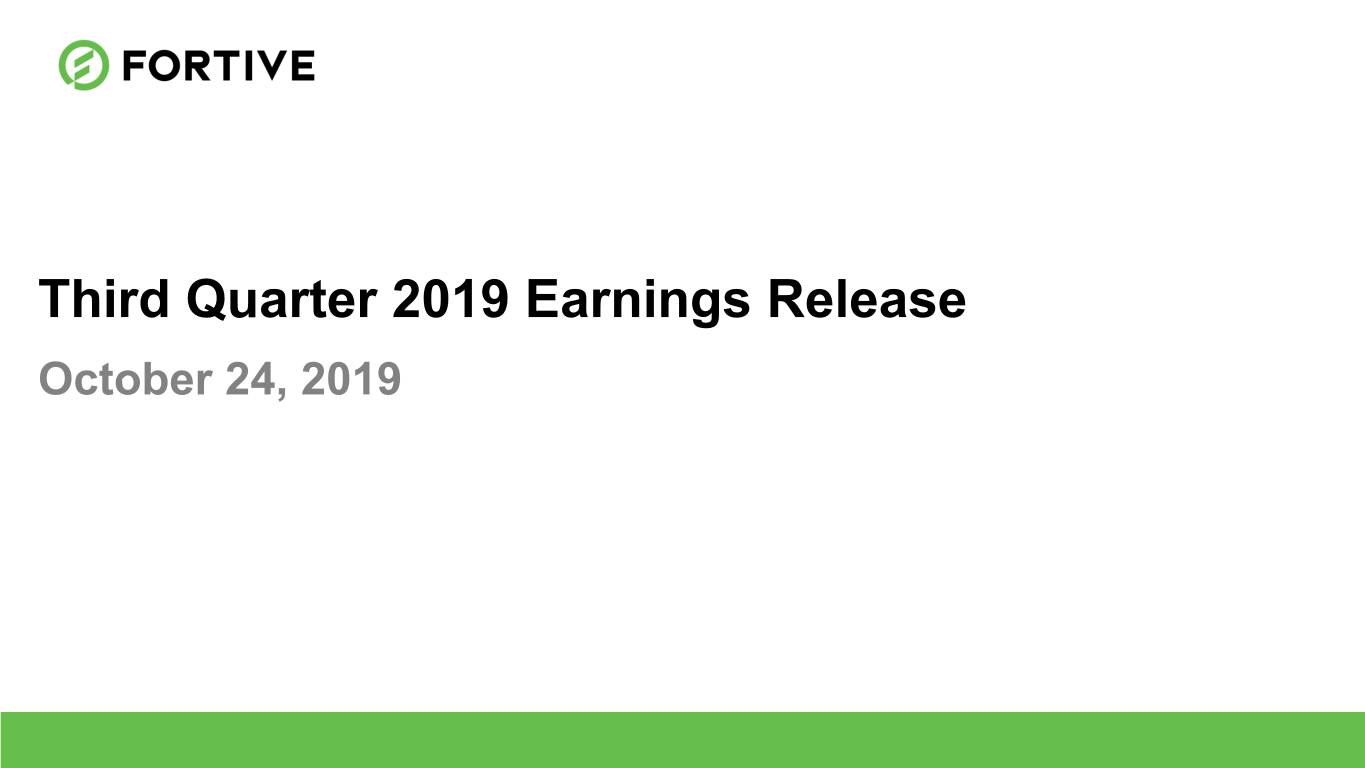
18
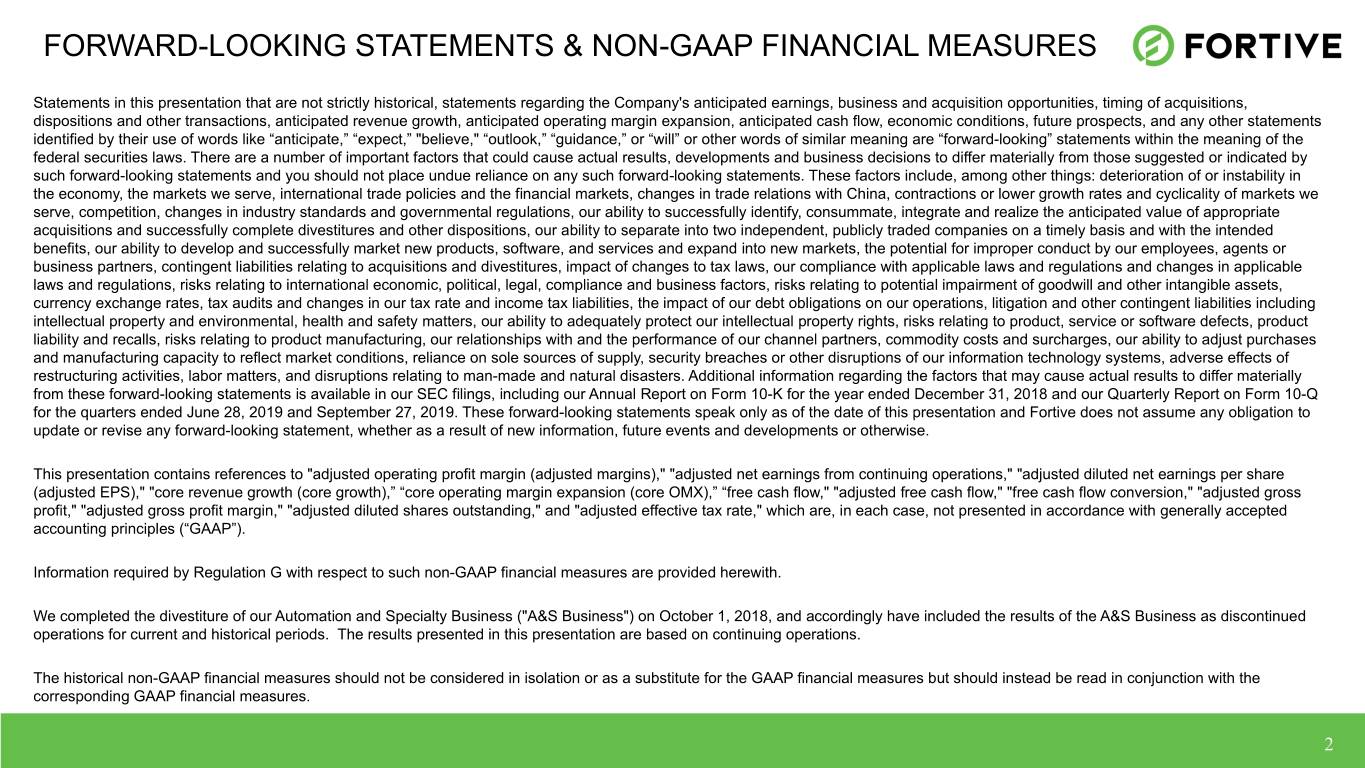
19

20
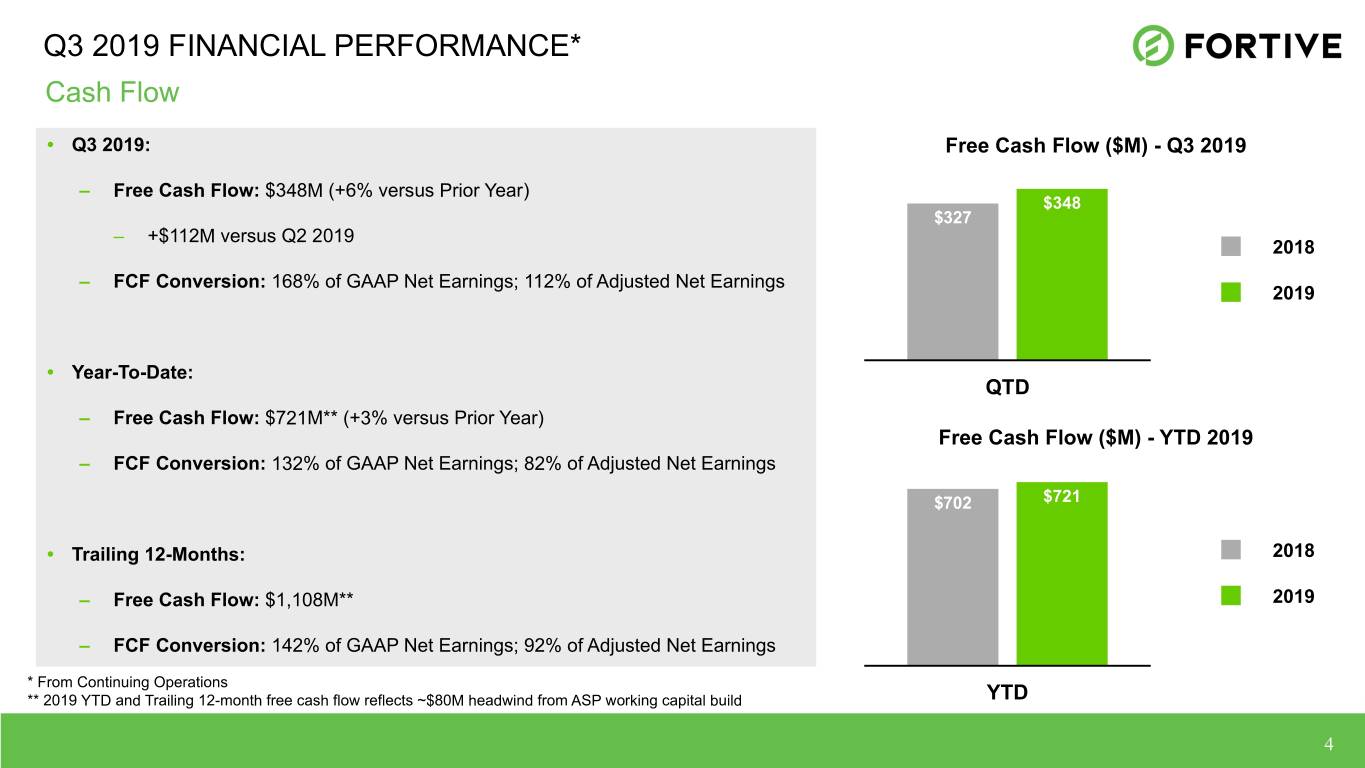
21
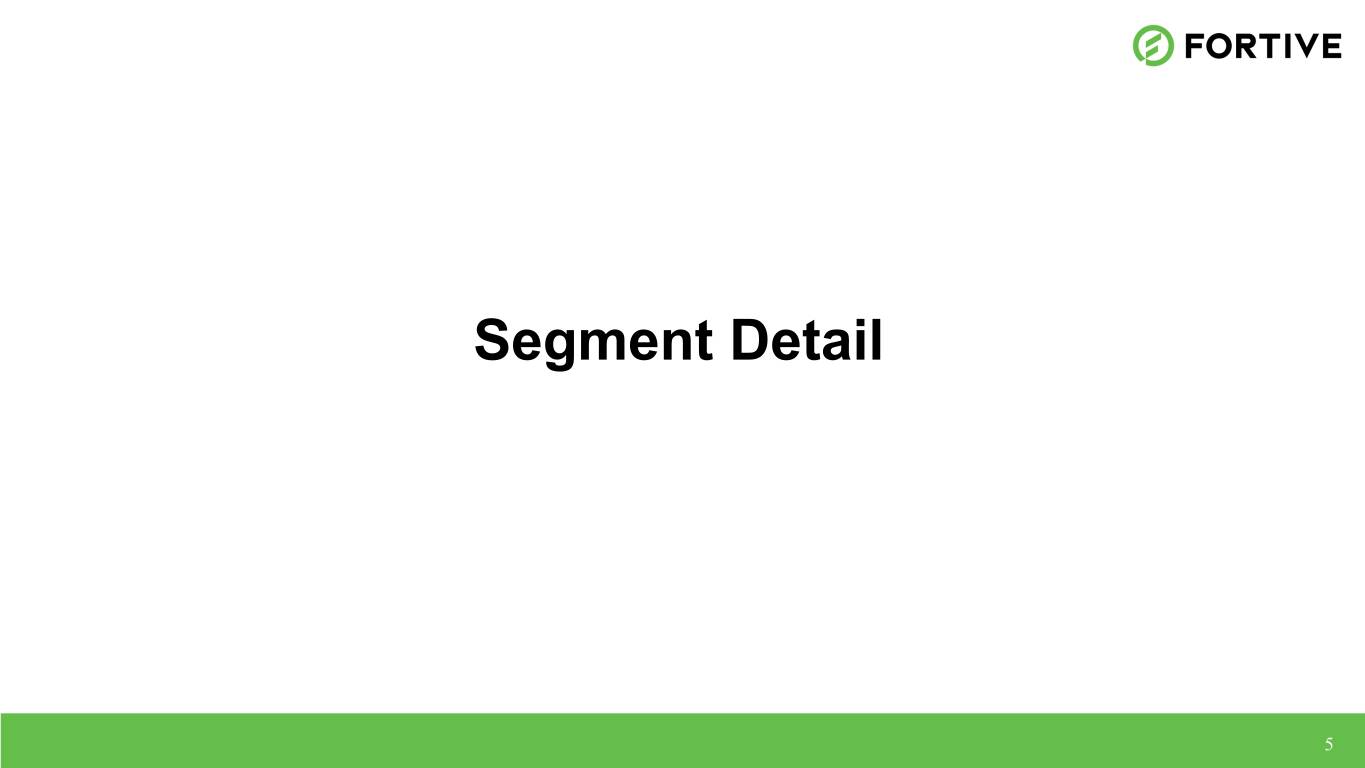
22
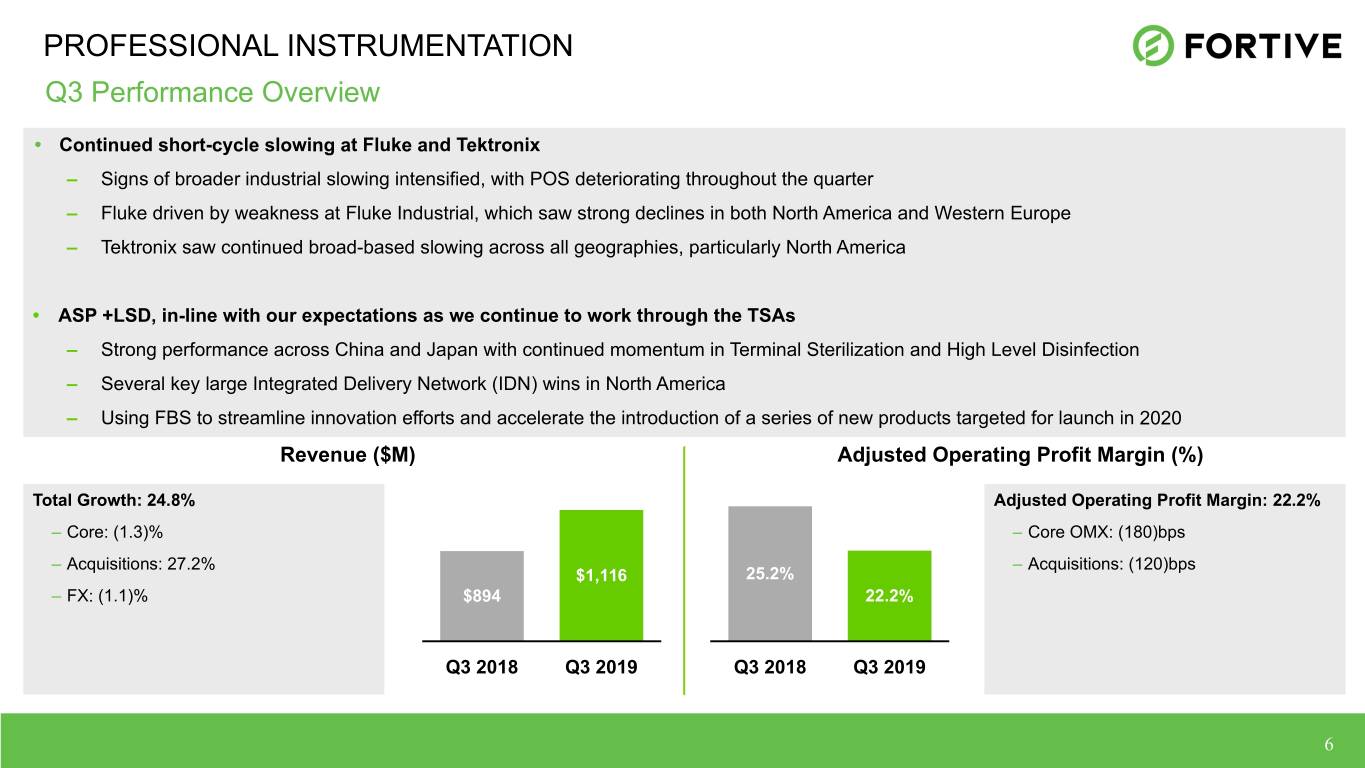
23
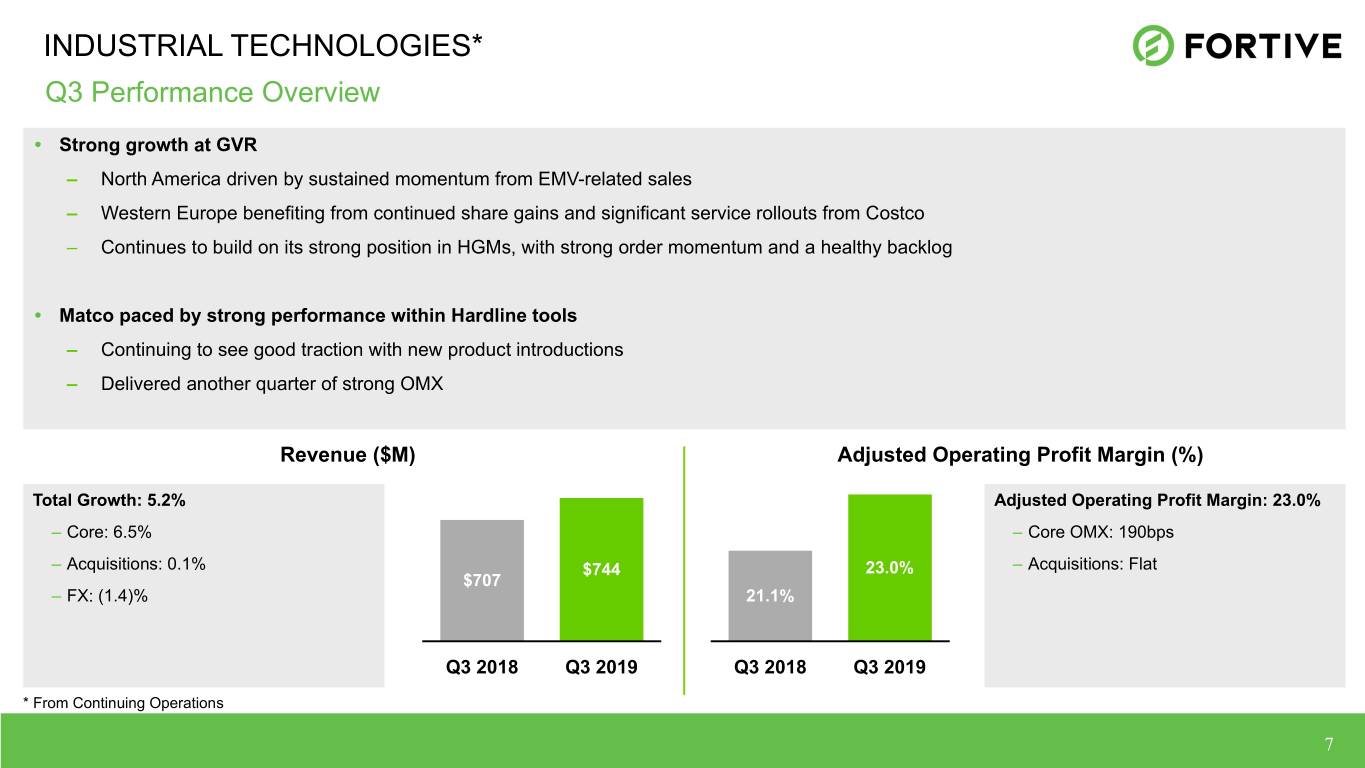
24

25

26

27
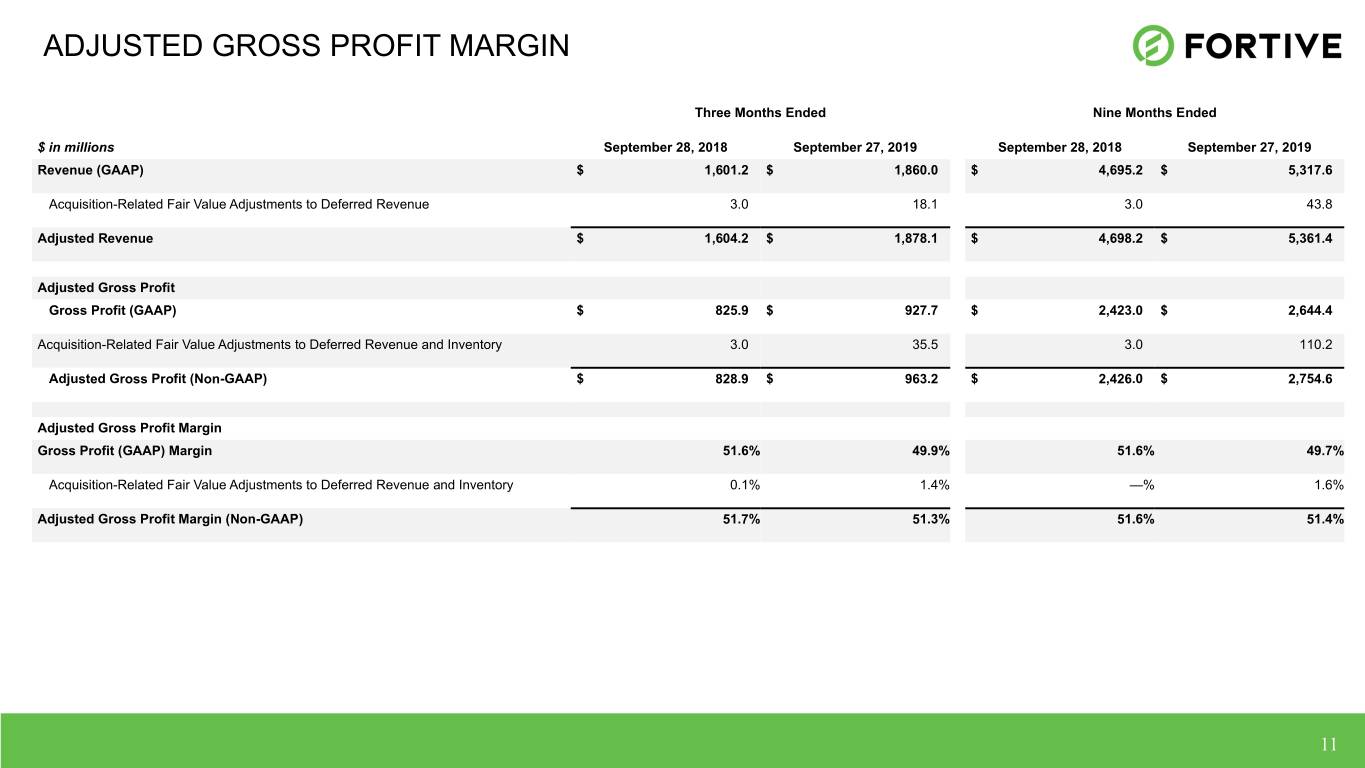
28
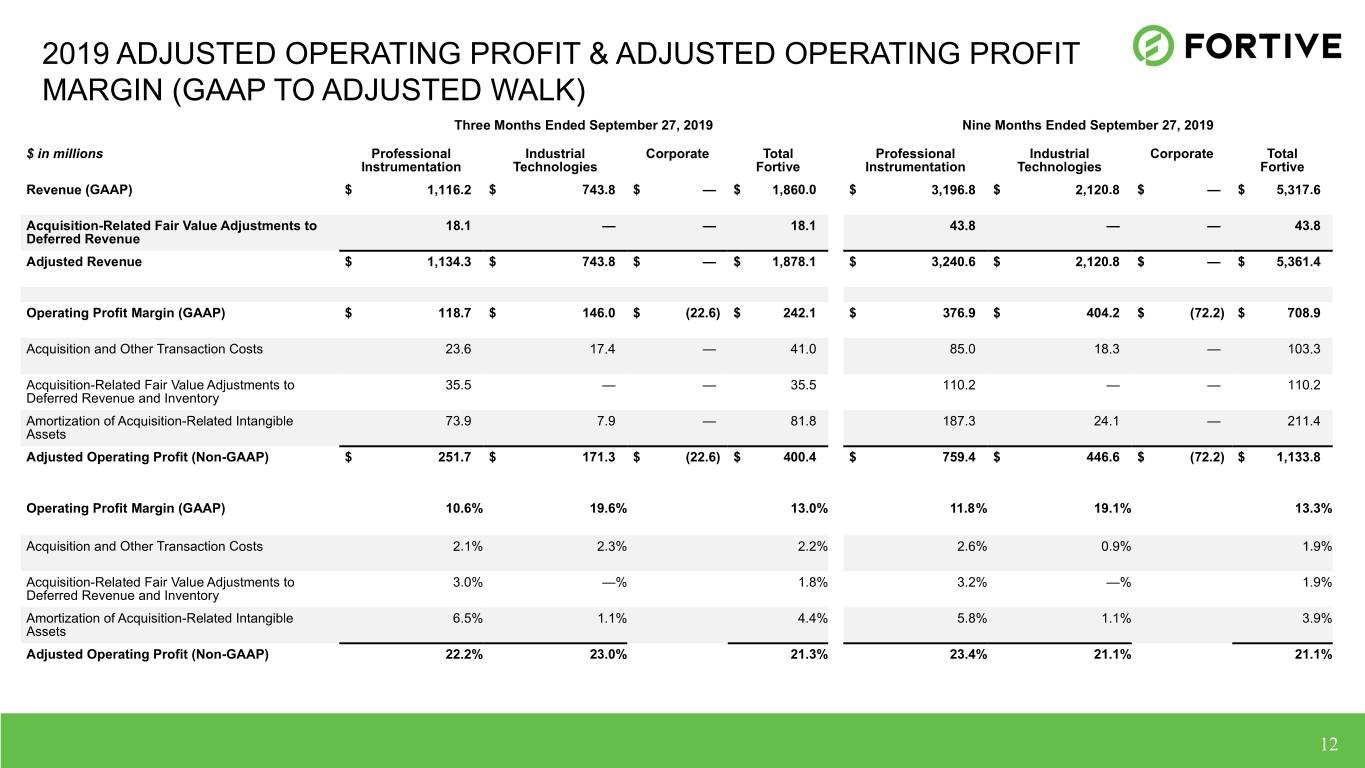
29

30
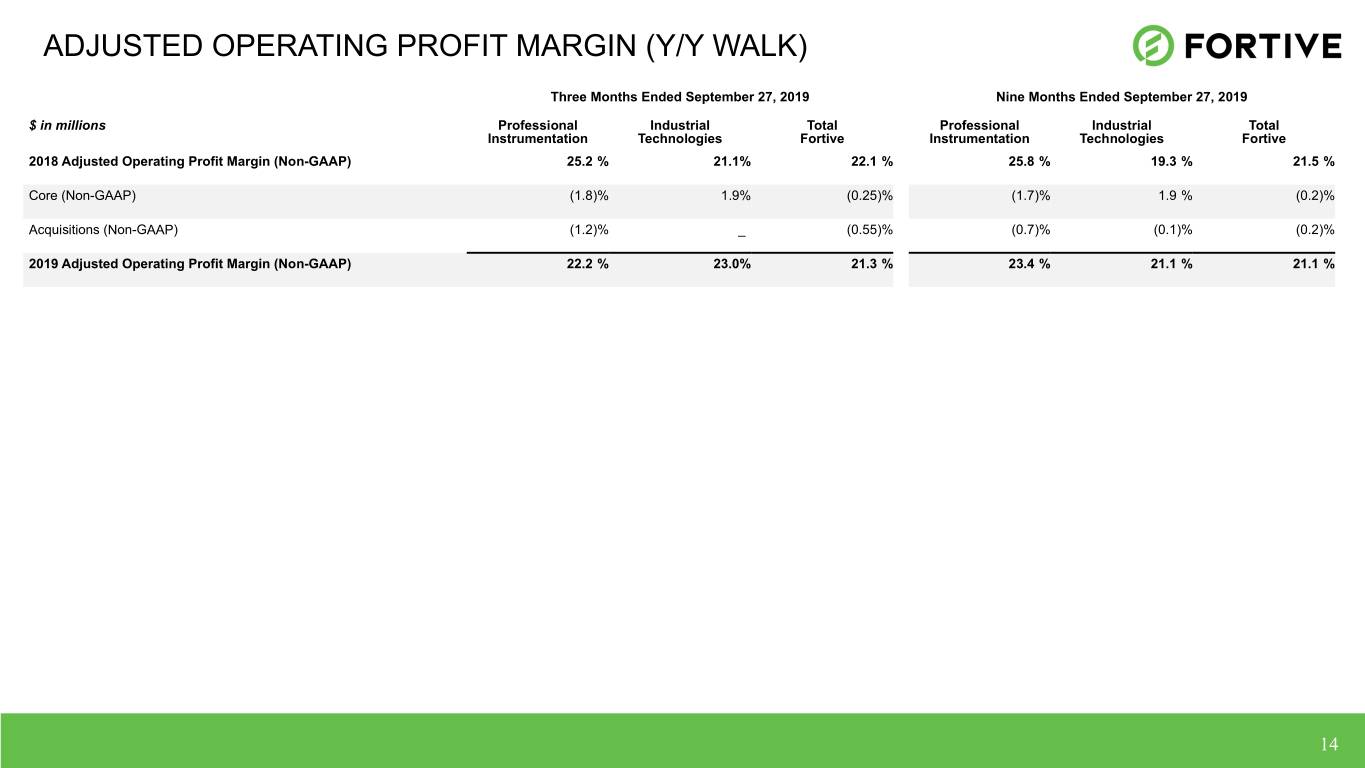
31
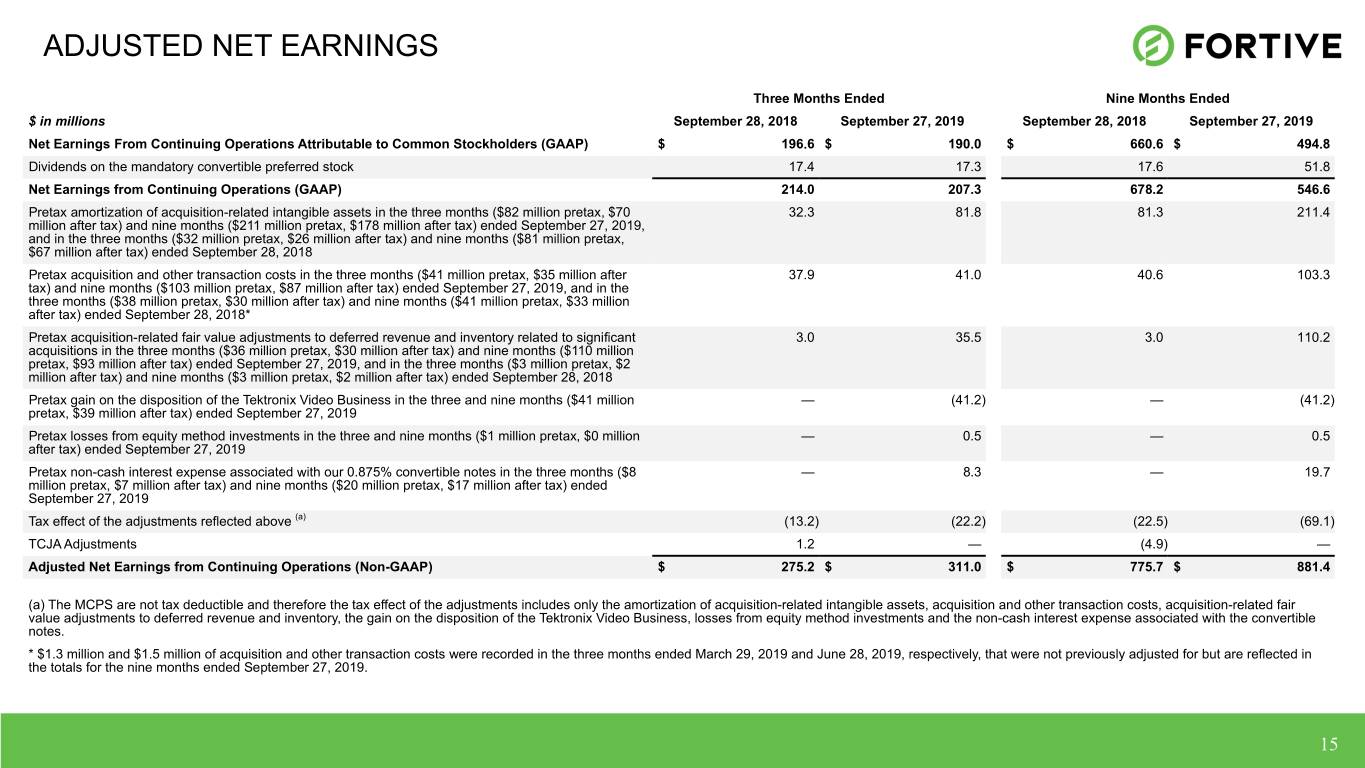
32

33
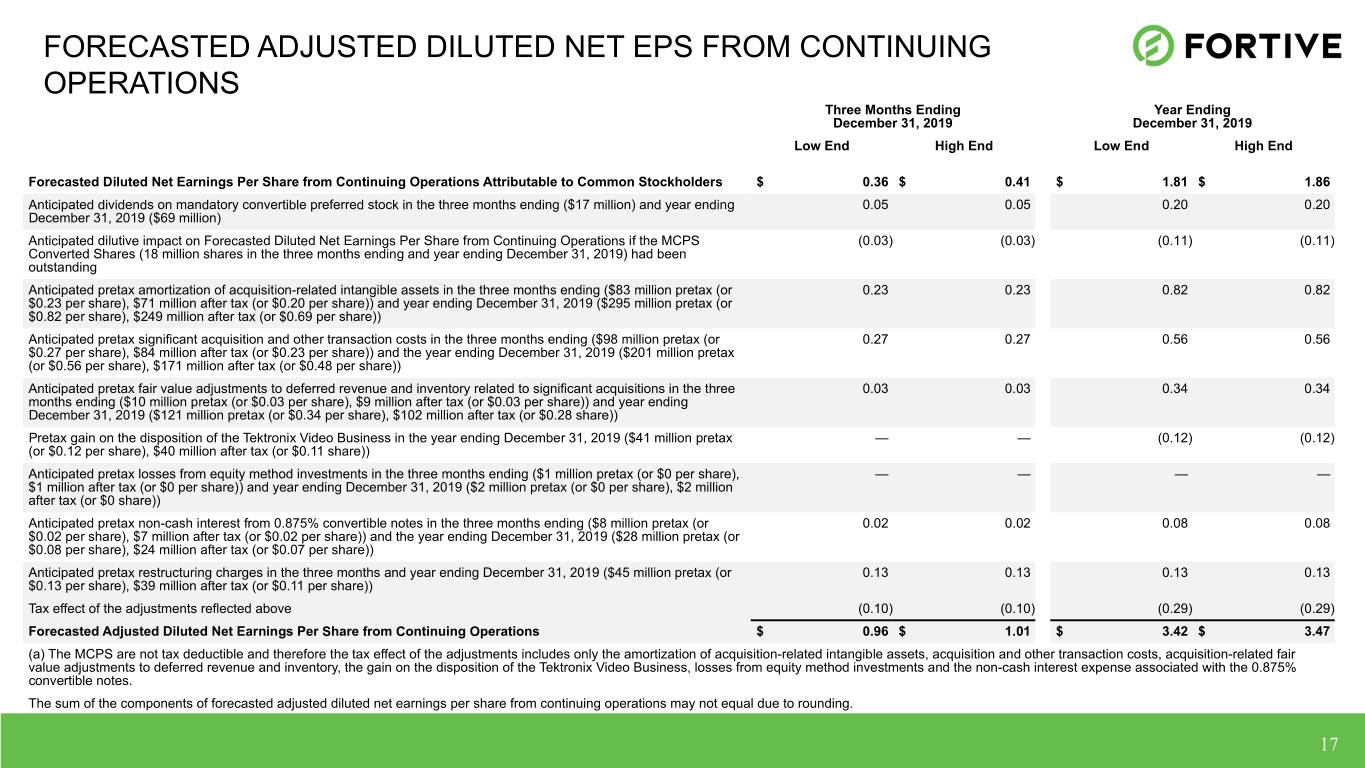
34
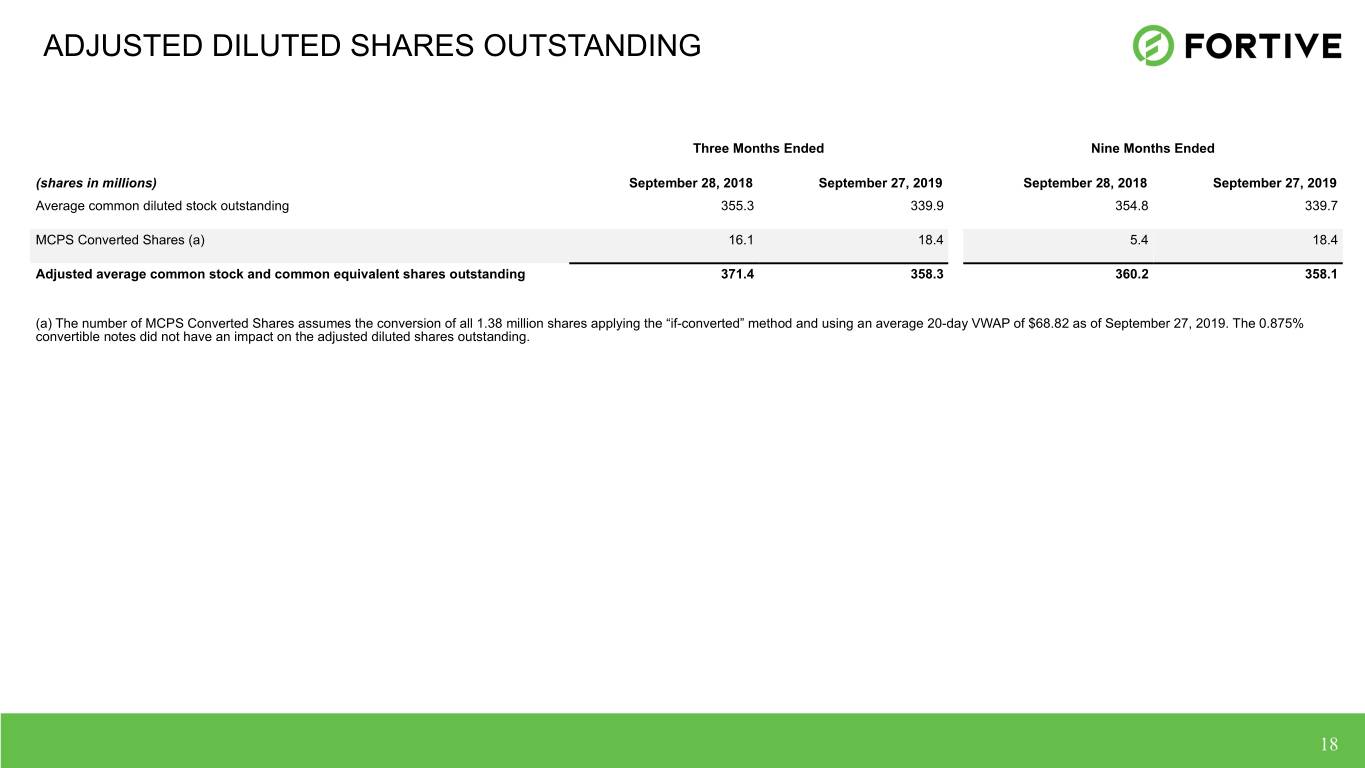
35
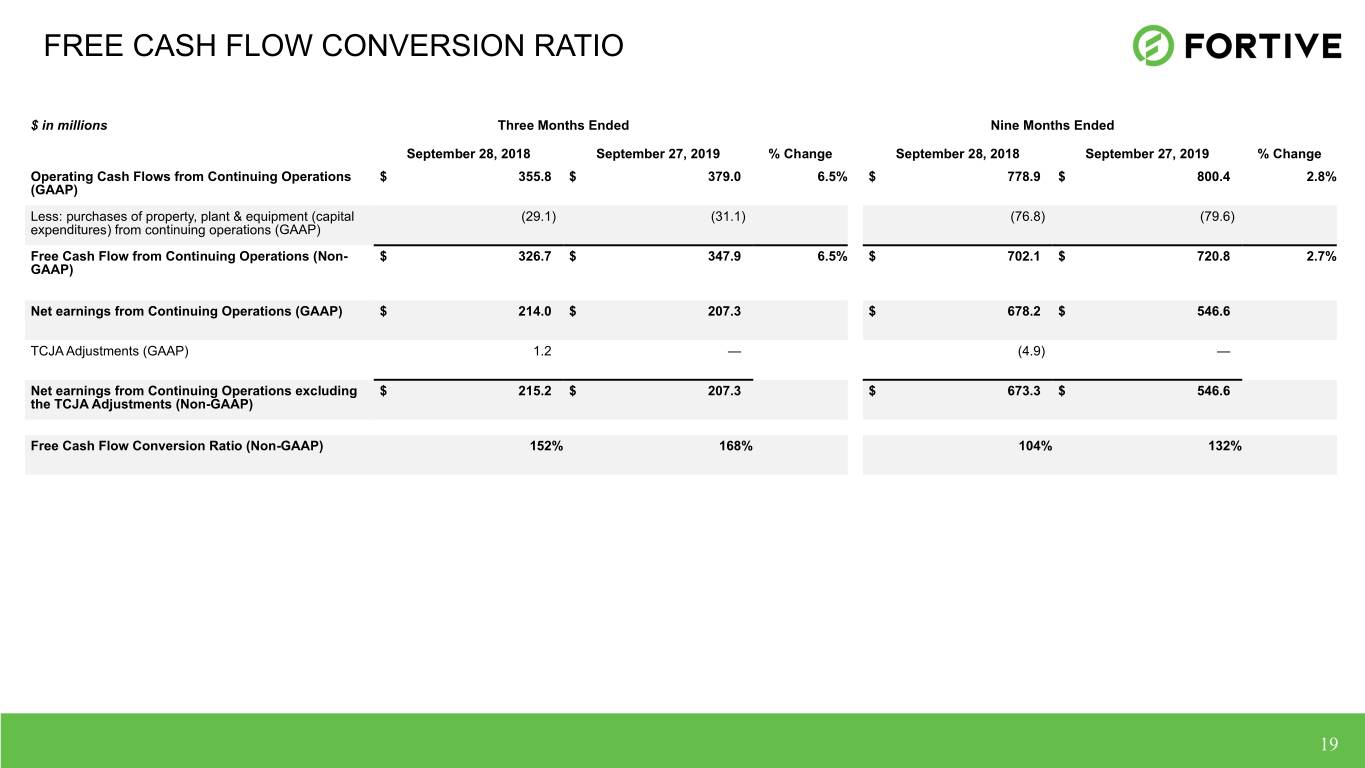
36
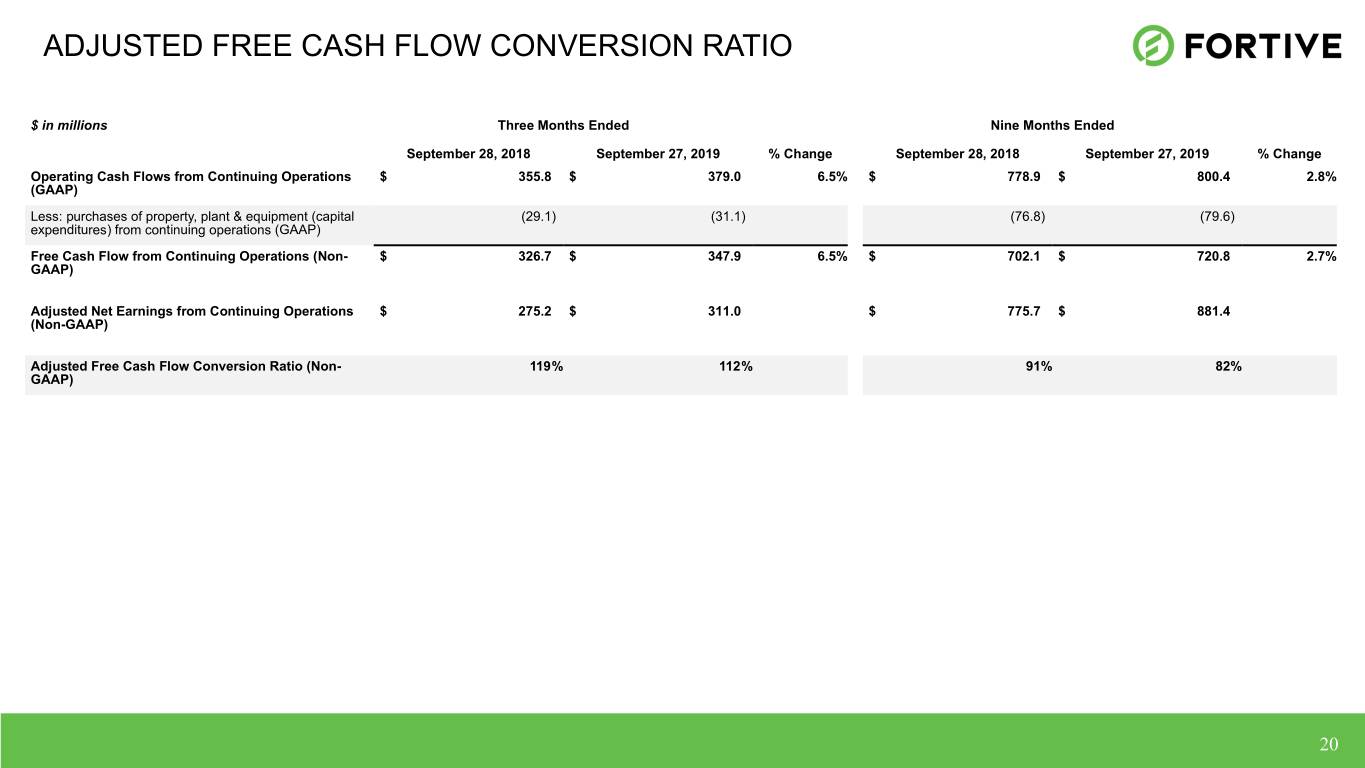
37
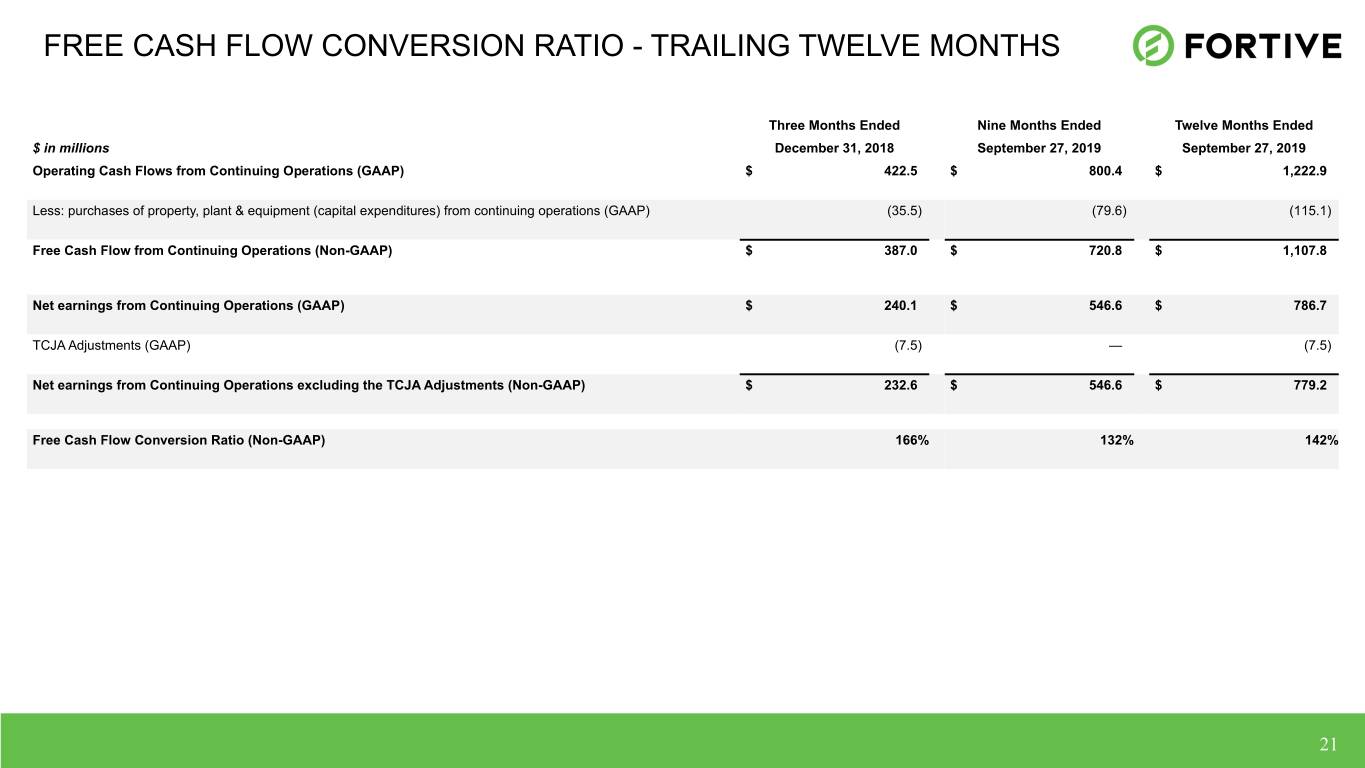
38
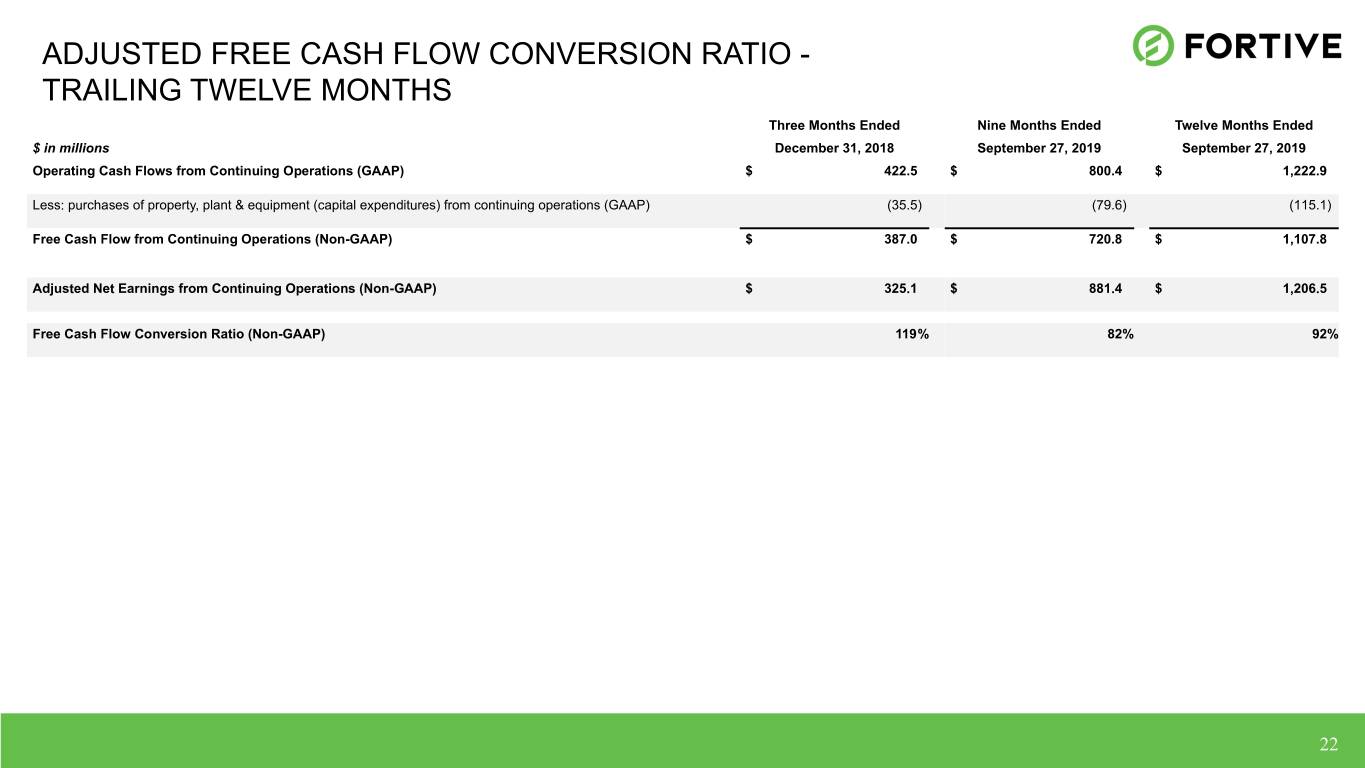
39
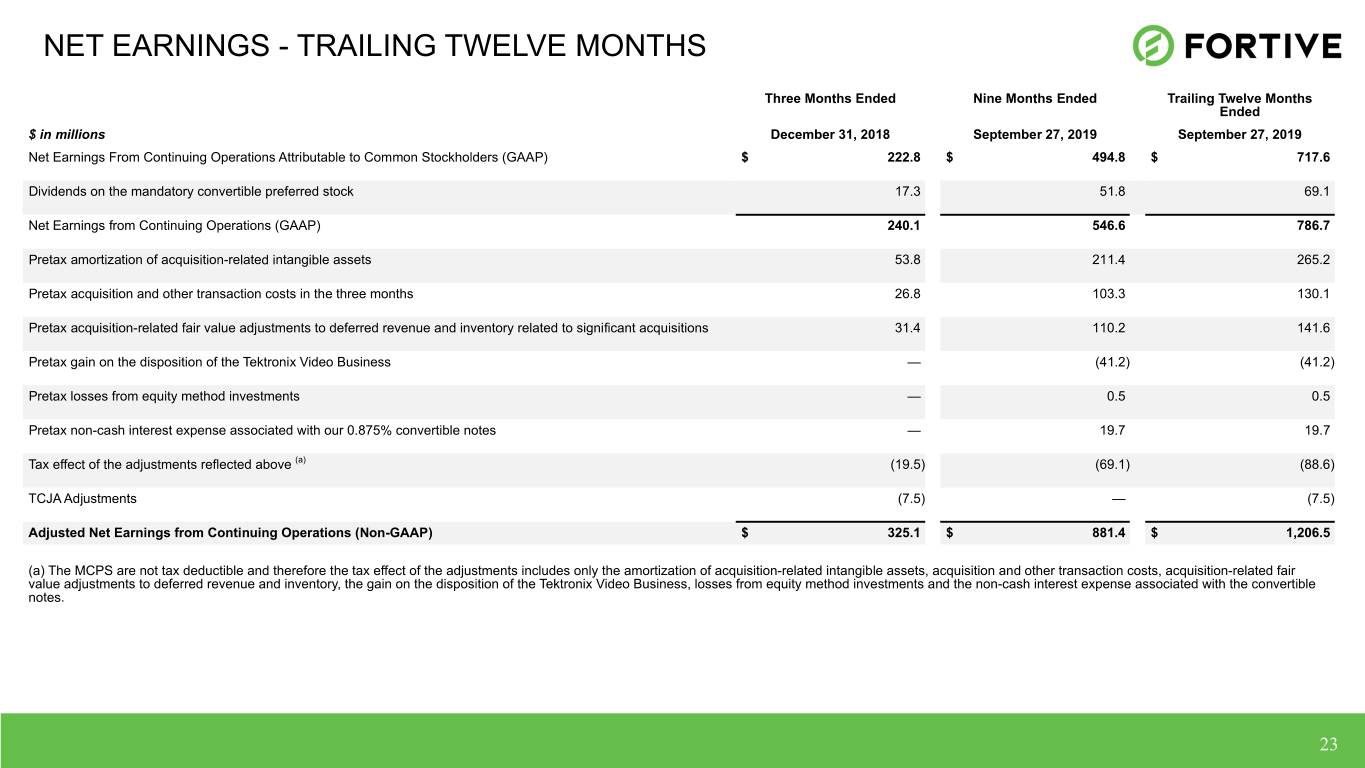
40
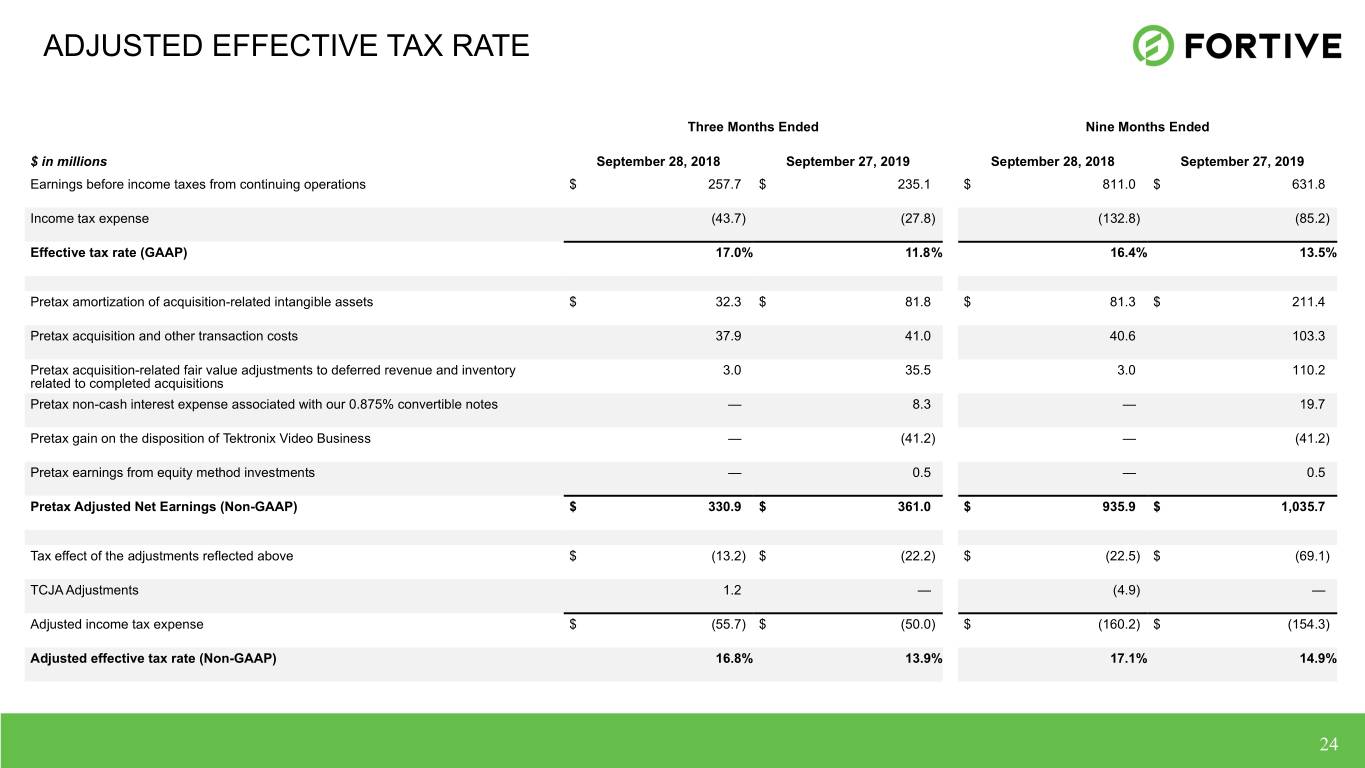
41
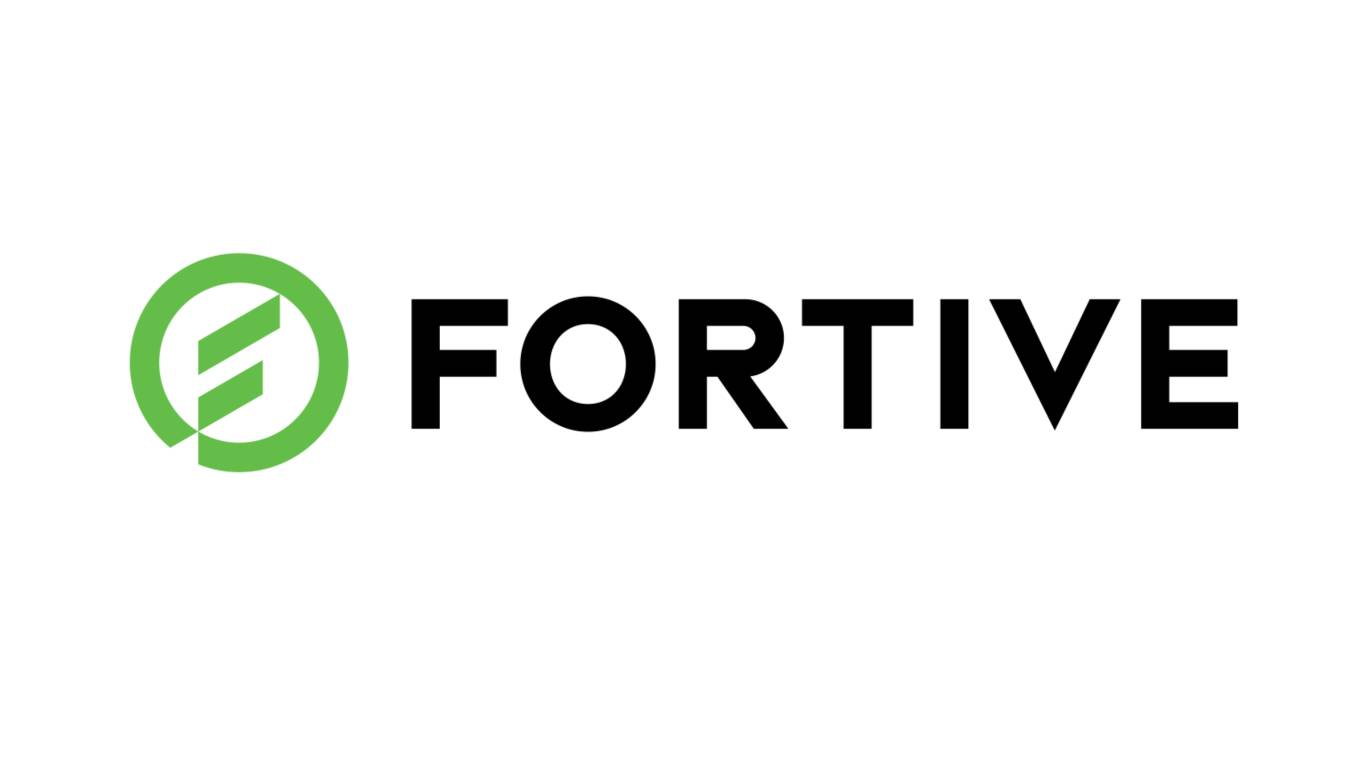
42
Q3 2019 Earnings Conference Call Transcript
Operator:
My name is Philip, and I will be your conference facilitator this afternoon. At this time, I would like to welcome everyone to Fortive Corporation's third quarter 2019 earnings results conference call. All lines have been placed on mute to prevent any background noise. After the speaker's remarks there will be a question-and-answer session.
I would now like to turn the call over to Mr. Griffin Whitney, Vice President of Investor Relations. Mr. Whitney, you may begin your conference.
Griffin Whitney, Vice President-Investor Relations, Fortive Corporation:
Thank you, Philip. Good afternoon everyone and thank you for joining us on the call. With us today are Jim Lico, our President and Chief Executive Officer, and Chuck McLaughlin, our Senior Vice President and Chief Financial Officer.
We present certain non-GAAP financial measures on today's call. Information required by SEC Regulation G relating to these non-GAAP financial measures are available on the Investors Section of our website, www.fortive.com, under the heading Financial Information.
We completed the divestiture of the Automation & Specialty Business on October 1, 2018, and accordingly have included the results of the A&S Business as discontinued operations for current and historical periods. The results presented on this call are based on continuing operations.
During the presentation, we will describe certain of the more significant factors that impacted year-over-year performance. All references to period-to-period increases or decreases and financial metrics are year over year on a continuing operations basis.
During the call, we will make forward-looking statements within the meaning of the federal securities laws including statements regarding events or developments that we expect or anticipate will or may occur in the future. These forward-looking statements are subject to a number of risks and uncertainties and actual results might differ materially from any forward-looking statements that we make today. Information regarding these factors that may cause actual results to differ materially from these forward-looking statements is available in our SEC filings, including our Annual Report on Form 10-K for the year ended December 31, 2018. These forward-looking statements speak only as of the date that they are made, and we do not assume any obligation to update any forward-looking statements.
With that, I'd like to turn the call over to Jim.
James A. Lico, President, Chief Executive Officer & Director, Fortive Corporation:
Thanks, Griffin, and good afternoon, everyone.
Today, we reported adjusted diluted earnings per share of $0.87 for the third quarter of 2019, representing an increase of 18% year over year despite short cycle slowing that intensified over the course of the quarter. While these challenges impacted growth in certain parts of our Professional Instrumentation segment, a double-digit increase in earnings and strong cash flow performance demonstrated both a contribution from our recent acquisitions and the strength of Fortive Business System to provide resilience to our portfolio.
As we navigate the slowing in the short-term, we continue to invest in our businesses to drive organic innovation, fuel further compounding and execute our capital allocation strategy to strength our long-term competitive advantage across the portfolio.
We've completed a significant amount of deal activity over the past three years and the execution of our capital allocation strategy continues. We have owned Advanced Sterilization Products for a little more than two quarters and we are pleased with its performance thus far and continue to make substantial progress with this integration.
In the coming weeks, we will close on China representing a significant step forward as we bring the remainder of ASP's geographies under our direct control. As we roll off the transition services agreement and install key elements of the Fortive Business System in the coming quarters, we will lay the groundwork for accelerated innovation and growth in the years ahead.
43
We also continue to make progress with respect to the intended separation of NewCo, which we announced on September 4th. Utilizing FBS, we have taken substantial steps forward with respect to our preparations, and we remain on track toward completing the transaction in the second half of 2020. We look forward to providing additional details on the transaction and updates on further milestones for NewCo in the coming weeks and months.
With that, I'd like to turn to the details of the quarter. Adjusted net earnings were $311 million, up 13% over the prior year, and adjusted diluted net earnings per share were $0.87.
Sales grew 16.2% to $1.9 billion, reflecting a core revenue increase of 2.1%, and the contribution from recent acquisitions. Core revenue growth was highlighted by strong performance at Gilbarco Veeder-Root and PacSci EMC, which was partially offset by declines in the short-cycle businesses within Professional Instrumentation, including Fluke, Tektronix and some parts of Sensing Technologies. Unfavorable foreign currency exchange rates reduced growth by 120 basis points.
Geographically, developed markets core revenue grew low single digits, reflecting the slowing macro conditions across both North America and Western Europe. Core revenue growth in North America was low single digits, led by GVR, EMC and Industrial Scientific, while Western Europe grew slightly.
High-grow markets core revenue decreased low single digits due to the loss of Huawei-related revenue at Tektronix and weaker market conditions in the Middle East.
China posted slightly positive growth as strong performance at Fluke and Qualitrol was largely offset by a decline in Tektronix, due to the Huawei impact, and flat performance of GVR. India was flat as growth at Fluke and Qualitrol was offset by timing delays for certain large project rollouts at GVR, which are now expected to start in the fourth quarter.
Adjusted operating profit margin was 21.3%, representing a year-over-year decrease of 80 basis points, including 55 basis points of dilutive operating margin associated with acquisitions.
Core operating margins decreased 25 basis points as the continued slowing within Professional Instrumentation more than offsets strength at GVR and another solid quarter of operating margin expansion in Matco.
During the third quarter, we generated $348 million of free cash flow or a sequential increase of $111 million from the second quarter. This free cash flow performance represented a conversion ratio of 168%.
Turning to our segments, Professional Instrumentation posted sales growth of 24.8% despite a low single-digit decrease in core revenue. The significant contribution of recent acquisitions, most notably ASP, continued to drive overall growth within Professional Instrumentation. Unfavorable foreign currency exchange rates reduced growth by 110 basis points.
Segment level adjusted operating margin was 22.2%, representing a year-over-year decrease of 300 basis points, including 120 basis points of dilutive operating margin associated with acquisitions.
Core operating margins decreased 180 basis points, reflecting a combination of slower revenue performance, the impact of tariffs and unfavorable foreign currency exchange.
Advanced Instrumentation & Solutions core revenue decreased low single digits as strong performance at EMC was more than offset by continued slowing across Fluke and Tektronix.
Field solutions core revenue decreased low single digits, including a low single-digit decline in developed markets driven primarily by slowing at Fluke in North America.
High-growth markets increased low single digits, driven by growth at Fluke and strong performance from Qualitrol in China.
Fluke's core revenue declined mid-single digits due to a high single-digit decrease at Fluke Industrial. Fluke Digital Systems grew greater than 20%, led by strong growth at eMaint, which generated a 10% increase in net new customers and a greater-than-20% increase in annual recurring revenue.
From a geographic perspective, the slowing that emerged at the end of the second quarter became more pronounced in the third quarter, particularly in North America, which saw a high single-digit decrease in revenue with slowing point-of-sale trends.
44
Fluke generated mid-single-digit growth in China, driven by strong performance across Fluke Industrial, Process Instruments, and Fluke Networks. Fluke Health won a multi-million-dollar order for RadWatch, a product developed in collaboration with the US Army, to monitor and measure radiation dosage.
The acquisition of PRUFTECHNIK closed at the beginning of the quarter and has gotten off to a solid start. We are excited about the integration of PRUFTECHNIK enhances Fluke's offering and capabilities with respect to asset reliability and condition monitoring.
ISC delivered low single-digit core growth as decreases in Western Europe and China partially offset stronger performance in North America. ISC's lower core growth in the quarter reflected a decline in instrument sales, which tend to be more sensitive to broader macro slowing.
ISC's iNet offering had another strong quarter, generating mid-teens growth as ISC continues to increase its share of subscription-based recurring revenue. ISC also recently launched the WiFi-enabled Ventis Pro5 multi-gas monitor, ISC's first direct-to-cloud product and a key step forward for ISC's emerging “connected worker” safety initiative.
The integrations of both Intelex and Safer Systems are progressing well, positioning ISC to significantly advance its safety-as-a-service strategy to provide real-time solutions for its customers’ environmental, health and safety-related workflows.
Qualitrol's core revenue declined low single digits as the continued challenges in North America, Western Europe and the Middle East were partially offset by greater than 20% growth in China, and greater than 30% growth in Latin America.
Qualitrol saw mid-teens growth in their basic sensors product line driven by share gains and is starting to see early signs of more positive bookings momentum heading into the fourth quarter.
Our facilities and asset management businesses, Gordian and Accruent both rolled core during the third quarter, but had a relatively small effect on the core performance of Professional Instrumentation, given the partial period. These businesses continue to perform well, generating high single-digit core growth.
Gordian's procurement platform in particular continues to drive strong growth, paced by increased construction volume with large enterprise customers, including the New York City Department of Education. Gordian also recently closed its largest facility planning deal to date, with CommonSpirit Health Systems to complete a facility condition assessment across its entire network.
Accruent saw slower growth in the quarter due to softer licensing revenue as it transitions customers away from certain legacy products towards its higher growth SaaS offerings. The company continues to generate strong SaaS bookings, with its sales team increasingly driving enterprise customers towards longer-term subscription-based contracts with higher total contract value.
Accruent added more than 70 customers in the third quarter, while significantly expanding its existing contract with Cushman & Wakefield to cover a broader range of offerings across Accruent's software platform.
Product realization core revenue decreased slightly, as strong growth at both EMC and Invetech was offset by continued weakness at Tektronix. EMC generated another quarter of broad-based double-digit sales growth across both its core defense product lines and its commercial satellite offering. EMC continues to maintain a very strong backlog with large recent customer wins and increasing momentum among commercial satellite operators, providing the company with excellent revenue visibility into next year.
Tektronix registered a high single-digit decrease in core revenue. Tektronix continued to be negatively impacted by slowing at Keithley, broad-based weakness in Western Europe, and the loss of its Huawei business due to the US Government imposed trade restrictions earlier this year.
While Tektronix registered strong growth from its high-performance oscilloscopes, driven by the 5G buildout in China, it also saw further slowing in North America, including a low double-digit decline for its core mid-range scopes.
Negative point-of-sale trends present an ongoing challenge heading into the fourth quarter. Despite the macro challenges, which we expect to persist into next year, Tektronix continues to focus on business execution, driving gains in its strategic growth segments, including key data center and automotive wins during the quarter.
45
Core revenue for Sensing Technologies decreased low single digits, as growth in North America and China was more than offset by weakness in Western Europe. Anderson-Negele had a strong quarter using FBS commercial tools to drive continued share gains in adjacent segments of the food and beverage end-market.
Building on the momentum in its environmental monitoring offering, Setra recently launched its Setra Lite product line, providing a simple, cost-effective, and highly visible solution to address pressure monitoring requirements in hospital rooms, which has been very well received by the market.
Turning to Advanced Sterilization Products, the company grew low single digits, in line with our expectations, as we continue to work our way through the completion of the transition services agreements. ASP's growth was led by strong performance in China and Japan, which saw continued momentum in Terminal Sterilization as well as strong growth in high-level disinfection tied to the recent launch of its new automatic endoscope reprocessor product line for the Japanese market.
ASP also landed some key wins in North America, expanding its footprint and overall portfolio in strategic integrated delivery networks in both Texas and Illinois. The ASP team has begun to apply the Fortive Business System to streamline its innovation efforts and accelerate the introduction of a series of new products targeted for launch in 2020.
Consistent with our strategy to build strong positions and connected workflows, we recently signed an agreement to acquire Censis, a leading provider of instrument tracking software, as a key addition to our sterilization offering. Censis provides central sterilization departments with front-line error prevention tools and analytics, which help improve efficiency and productivity in sterilization workflows, optimize compliance reporting, and reduce the risk of hospital-acquired infections. We expect the acquisition to close before the end of the year.
Moving to Industrial Technologies, revenue grew 5.2%, including core revenue growth of 6.5%. Acquisitions contributed 10 basis points of growth, while unfavorable foreign exchange rates reduced growth by 140 basis points. Segment level adjusted operating margin was 23.0%, including a core operating margin increase of 190 basis points, driven by the continued strong volume at GVR and solid performance at Matco.
Our transportation technologies platform core revenue grew high single digits, led by mid-teens growth in North America. GVR delivered low double-digit core revenue growth, highlighted by a mid-teens increase in developed markets. GVR's performance in North America was paced by sustained momentum from EMV-related sales, while growth in Western Europe reflected a combination of continued share gains and significant service rollouts with Costco during the quarter.
GVR posted flat growth across high-growth markets, and strong performance in Latin America was offset by continued delays from automation project rollouts in India, as well as a large dispenser tender, for which expected delivery has been shifted into the fourth quarter.
Despite these short-term dynamics, GVR continues to build on its strong position within high-growth markets and India in particular, as strong order momentum and a healthy backlog provide good visibility into the region's sustained growth in the coming quarters.
GVR recently launched Passport Express Lane, adding a self-checkout system optimized for convenience stores to its Passport suite of solutions. GVR also launched a new family of products for Insite360 called HALO, which provide a significant upgrade to the system's field fuel logistics functionality.
During the third quarter, we made a follow-on investment in Tritium, as we continue to support the company's rapid growth. GVR also recently announced the integration of a credit card reader into Tritium's high-speed EV charging stations, enhancing payment functionality to include credit card, debit card, and contactless payment methods.
Teletrac Navman performed in line with expectations, generating a low teens core revenue decrease in the third quarter, as continued strong growth across Asia-Pacific was more than offset by the company's performance across North America and Western Europe. The key priority for the Teletrac Navman team remains the stabilization of its business in North America as it addresses the high level of customer churn over the past 12 months and returns the company to a sustainable growth trajectory. We continue to see improvements in our customer-related metrics, including the level of customer churn.
Moving to franchise distribution, the platform's core revenue grew low single digits during the third quarter, as low single-digit growth at Matco was partially offset by a low single digit decline at Hennessy. Matco was led by another strong quarter of growth in hardline tools, offset by some slowing in tool storage.
46
Matco continues to see good traction with new product introductions, highlighted by the recent launch of a new half-inch air impact wrench with a market-leading combination of power and control and a lightweight design that makes it significantly easier for the technician to handle.
Before turning to the guide, as we look ahead to 2020, we are mindful of the challenging macroeconomic environment and are, therefore, planning to increase our spending on a range of strategic productivity initiatives by approximately $45 million in the fourth quarter.
These initiatives will better position us to deliver sustained earnings growth, while maintaining investments to drive future growth and innovation.
We are updating our full year 2019 adjusted diluted net EPS guidance to $3.42 to $3.47, representing year-over-year growth of 12% to 13% on a continuing operations basis. The revised annual guide reflects the headwinds faced by our Professional Instrumentation segment due to the short-cycle slowing dynamics that became more pronounced in the third quarter, and which we expect to persist through the end of the year. The revised guidance assumes 1% to 2% core revenue growth and an effective tax rate of approximately 15%.
We are also initiating our fourth quarter adjusted diluted net EPS guidance of $0.96 to $1.01 representing year-over-year growth of 5% to 11%. This includes assumptions of flat core revenue growth, flat core OMX and an effective tax rate of approximately 15%.
To wrap up, during the third quarter we delivered high teens earnings growth with strong free cash flow, even as the macroeconomic backdrop became more challenging. The quarter demonstrated the powerful earnings contribution from the acquisitions we have added over the past few years, which are also increasing the resilience of our portfolio as they compound and become a larger share of our total revenue.
Despite short-cycle slowing and the headwinds we expect to persist into next year, we continue to execute our capital allocation strategy to drive further portfolio transformation, build a better, stronger Fortive and create greater long-term value for employees, customers and shareholders.
With that, I would like to turn it over to Griffin.
Griffin Whitney, Vice President-Investor Relations, Fortive Corporation:
Thanks, Jim. That concludes our formal comments. Philip, we're now ready for questions.
Operator:
Your first question is from the line of Steve Tusa with JPMorgan.
C. Stephen Tusa, Analyst, JPMorgan Securities LLC:
Hey, guys. Good afternoon.
James A. Lico, President, Chief Executive Officer & Director, Fortive Corporation:
Hi, Steve. How are you?
C. Stephen Tusa, Analyst, JPMorgan Securities LLC:
I'm doing all right. So, can you just help us a little bit with parsing out the acquisitions? How much of an impact on margin and then maybe easier just like what was the negative earnings impact from stuff that ran through from the deal that you closed in the third quarter, if there was any?
James A. Lico, President, Chief Executive Officer & Director, Fortive Corporation:
In the third quarter, the deal expenses, on our adjusted earnings, there's nothing in there that ran through there, and there really wasn't any headwinds related to the acquisitions. The headwinds we faced were largely about the slowing of the topline, as we progressed through the quarter.
47
C. Stephen Tusa, Analyst, JPMorgan Securities LLC:
Okay. And then when it comes to the deal that you were planning to contribute this year like, Gordian and Accruent, I think ASP is kind of a bit of a standout, that seems to be on track. Just remind us what you said they were going to contribute at the beginning of the year? And is that still the case here that they're going to contribute the same amount? Or is the Accruent comment that you made – I think it was Accruent you made a comment around, is that slowing, having an impact on what those are ultimately going to contribute?
James A. Lico, President, Chief Executive Officer & Director, Fortive Corporation:
So, I think that the ASP continues to be right on track on that $0.20. And I think what we said for Gordian and Accruent, I have to go back and look, but $0.24 to $0.28 for the year, and I think when we get there, they're largely intact. Keep in mind that probably a third of the OP from those things are in the fourth quarter, so I think that we continue to be in that range.
Operator:
Your next question is from the line of Deane Dray with RBC Capital Markets.
Deane Dray, Analyst, RBC Capital Markets LLC:
Thank you. Good afternoon, everyone.
James A. Lico, President, Chief Executive Officer & Director, Fortive Corporation:
Hey, Deane.
Deane Dray, Analyst, RBC Capital Markets LLC:
Hey. Maybe we can start with the market conditions. I know you pick your words carefully in the prepared remarks, but you said the short-cycle slowing “intensified.” And then, if I heard you correctly, did you say that you expect some of the slowness to persist into next year? So, take us through the cadence of the quarter, and then what this means in terms of outlook for 2020? I know you're not giving specific guidance, but just in terms of how long this persists?
James A. Lico, President, Chief Executive Officer & Director, Fortive Corporation:
Yeah, sure. Thanks, Deane. It's Jim, by the way. I would say that a couple of things. One, I will just take us back to where we are at in July. What we saw in July was mostly what we thought to be an inventory correction. Our point-of-sale in places like Fluke and Tek where we have the best visibility, that point-of-sale was still holding in there pretty well in June. But our sales into those channel partners was generally slower, so we saw it as a destocking, mostly.
As we progress through the quarter, we increasingly saw the degradation of point-of-sale, and I think that's what led us to what we believe to be true now is, this will continue to persist. And so our guide for the year really reflects what we've seen in terms of degradation on the point-of-sale side.
I would also say that we're starting to see it in our direct business as well, in some places. So it's not just a channel situation.
And typically, and I think this is probably more a Fluke comment, Deane, because of knowing the history there is that the smaller channel partners tend to be down more than the bigger ones too. So that's a dynamic that we typically see maybe for a more protracted slowdown than just a quarter or two.
To your question about what's our view of next year? I think you step back and you look at, we really took a significant look at where we were at for the productivity initiatives that we announced, the $45 million. I think we really have a construct in which we think a number of these things continue into next year.
So while I don't have a crystal ball for the full year right now, nor would I want to try to provide that, I think it's fair to say that when we snap the line on the calendar, things aren't probably likely to change all that much, and that it's at least likely into the first quarter and probably into the second quarter, a number of these things continue. And that's sort of our thought process at this point.
48
Deane Dray, Analyst, RBC Capital Markets LLC:
Great. I appreciate that color in terms of the expectations. And could you flesh-out a bit on this restructuring initiative? This is right out of the Danaher Playbook with year-end restructurings that you self-up for stronger, leaner coming year. The $45 million, what in terms of cash return might that be? How much is head count? Is there rooftops? And just some color there would be helpful. Thanks.
Charles E. McLaughlin, Chief Financial Officer & Senior Vice President, Fortive Corporation:
Hey, Deane. This is Chuck. I think the returns we'd expect on that would be under a year on that $45 million. There's a number of different places where we saw slowing in the quarter, with the initiatives across those businesses where we're seeing the primary slowing, so more focus in PI. Beyond that, given that we are just rolling those things out at the operating companies, I think, we'll leave the details for another day.
Operator:
Your next question is from the line of Julian Mitchell with Barclays.
Julian Mitchell, Analyst, Barclays Capital, Inc.:
Hi. Good afternoon. Maybe just a...
James A. Lico, President, Chief Executive Officer & Director, Fortive Corporation:
Hi, Julian.
Julian Mitchell, Analyst, Barclays Capital, Inc.:
Hey. Just a question around the sort of the Q3 performance and the Q4 guidance. So in the third quarter, you had I think 2% core growth and a slight decline in core margins. Q4, you're guiding for flat core sales and a flat core margin. So I just wondered with that slowdown in the top line that you've talked about, why don't we see that core margin pressure increase in Q4? Is it something to do with mix within the two segments? Or something around the tariff timing impact a year ago? Maybe just help us understand that margin dynamic. And maybe to put a point on it, the adjusted margin in Q3 was 21.3% just to clarify, if you can, what's the number for Q4?
Charles E. McLaughlin, Chief Financial Officer & Senior Vice President, Fortive Corporation:
Sure. First, I'll take the adjusted margin percentage in Q4 raises to 22.1%, for the full company. I think the main thing, mix plays certainly a part of it, and can give you some variations on the flat OMX, but I think when you look back to last year in Q4 we had some one-time things that aren't repeating, and so that gets us to a little bit better than what we saw in Q3. But if you look back over Q2 to Q3, it's been flat.
James A. Lico, President, Chief Executive Officer & Director, Fortive Corporation:
Julian, I think it also reflects what you saw in the third quarter was this sort of slowdown through the quarter. We're much more prepared from a fourth quarter standpoint for that slowdown. And so what you also see is us taking action and the impact of those actions actually really having more impact in the quarter.
So it's certainly we got some slightly easier comps on the tariffs, too, as you accurately pointed out, but it's also this ability for us to get after. The free cash flow in the third quarter was strong, we were certainly prepared on the working capital side, and I think we're better prepared on the P&L side in the fourth than say we were in the third.
Julian Mitchell, Analyst, Barclays Capital, Inc.:
Understood. And then maybe just my follow-up around capital deployment, you've announced the split which will happen 9 to 12 months from now. You've also got some restructuring underway today, because of slowing top line. Given those two aspects, do you think it's plausible that you would have much M&A activity in the coming two or three quarters? Or the view is you have a lot on your plate, and so maybe M&A takes a backseat for a while?
49
James A. Lico, President, Chief Executive Officer & Director, Fortive Corporation:
Well, I would say, first, we certainly would agree with the point that we have a focus on a number of things that are really important. We mentioned in the prepared remarks, both the ASP integration and the separation in the NewCo are going well, and that certainly takes time and resources and energy. So we would certainly vehemently agree that as a prioritization those things are top of mind, and things that Chuck and I and the rest of the management team are certainly focused on really on a daily basis.
We announced – we've done three deals, really, if you think about it from the second quarter when we closed ASP, we've done Safer, we've done Intelex, we've done PRUFTECHNIK, and of course today we announced the Censis deal, so now four deals in the better part of 90 days. So we've been pretty active, and we're certainly very focused on the integration of those things.
So I think Censis is a good example. As I mentioned at a couple of the conferences recently, we'd be more likely to be focused on anything if we did something to be bolt-on-ish, or maybe adjacent that's within the real strategic side. And I think Censis represents that. In many respects, it's adjacent to exactly what we do in sterilization. It's sort of like how Intelex is akin to ISC. It's very much akin to what we do at ASP. So I think we'll be focused on those kinds of transactions, if they are right down the middle of the fairway, we would be acting on, but we do have a focus on a number of these things. And while I wouldn't say we are not focused on M&A, I think it's safe to say that the M&A we've done is pretty considerable here recently.
Operator:
Your next question is from the line of Andrew Obin with Bank of America.
Andrew Burris Obin, Analyst, Bank of America Merrill Lynch:
Yes, good evening.
James A. Lico, President, Chief Executive Officer & Director, Fortive Corporation:
Hi, Andrew.
Andrew Burris Obin, Analyst, Bank of America Merrill Lynch:
Hi. How are you, guys? Can you hear me?
James A. Lico, President, Chief Executive Officer & Director, Fortive Corporation:
Yes.
Charles E. McLaughlin, Chief Financial Officer & Senior Vice President, Fortive Corporation:
Yes.
Andrew Burris Obin, Analyst, Bank of America Merrill Lynch:
Excellent. So, you did highlight North American slowdown in PI, and I was just wondering. What specific end markets would you attribute the slowdown to?
James A. Lico, President, Chief Executive Officer & Director, Fortive Corporation:
I would say first, in terms of location, we said it was, I would say we certainly saw where we were. If I think about Fluke, Fluke was – Fluke Industrial in particular, our Fluke Networks business as well, those are two places in North America.
So that was relatively broad-based, but you can certainly see where industrial customers were slower. We don't have a lot of automotive exposure, but we have manufacturing certainly in those numbers, and you'd see some of those places are just some examples of where you might see a little bit more end market slowing. Certainly electronics would be the other place where we saw it, so whether that's anyone assembling or designing electronics, we saw a little bit slower markets, and that's a channel dynamic as much as anything. So those are some end markets.
50
I think where we stood up, where we had innovation, we continue to do pretty well from a product perspective. The ii900, the Sonic Imager we announced last quarter at Fluke did exceptionally well in the quarter. Our Thermal Imaging product line did pretty well in the quarter. So where we had some innovation, we still saw some opportunity. So I think the key for us is to continue to find those places where there's opportunity and really utilize prioritization and what we call dynamic resource allocation to put our resources in some of those end markets.
I would say that when we look at places like where we have software conversion to SaaS, things are really well, so eMaint is a great example, as while the end market might be similar to some of the places that are slowing from an instrument standpoint, we're still seeing a lot of SaaS conversion in those end markets with maintenance software. We mentioned eMaint grew over 20% for another quarter in a row, and their performance was outstanding. So where we have those SaaS conversions, Andrew, I would say the end market almost doesn't matter, we're still doing pretty well.
Andrew Burris Obin, Analyst, Bank of America Merrill Lynch:
And just a follow-up question on Tektronix, there's been some headlines that we're seeing stabilization sort of semiconductor market specifically. Has your view changed on that into fourth quarter and next year? Are you seeing any signs of stabilization? Does it matter for Tektronix where we are right now?
James A. Lico, President, Chief Executive Officer & Director, Fortive Corporation:
I think it's still a little early for us to call it stabilization. I would say on the capital front, the onesie-twosie stuff might be something that continues, but some of the bigger projects like our Keithley business as a decent bellwether there, we still haven't seen a big upturn, or maybe even a flattening yet. So I think we're still at least a quarter – I've heard some of the same things, but I think we're definitely not planning for any of that in the rest of the year.
Operator:
Your next question is from the line of Andy Kaplowitz with Citi.
James A. Lico, President, Chief Executive Officer & Director, Fortive Corporation:
Hey, Andy.
Andrew Kaplowitz, Analyst, Citigroup Global Markets, Inc.:
Hey, good evening guys. Jim or Chuck, you said you had 150 basis points of price this quarter, which seems like a good deal of price. But could you talk about the trade-off between price versus cost across the company? I know you lapped tariffs in Q3, but did you have positive price versus cost in Fluke and Tektronix in particular? And if you didn't, how quickly could pricing catch up with cost in those segments? And what should it look like for the company moving forward?
James A. Lico, President, Chief Executive Officer & Director, Fortive Corporation:
I think both at Fluke and at Tek in the quarter we beat the corporate average from a price standpoint. I think we're still a little behind on the price/cost dynamic at both those places. We've got some cost reductions that have offset some of those, but from just a pure price tariff, Andy, we're still lagging a little bit relative to that. And I think as we go into the year, that obviously tapers a little bit, because we've start to sunset some of the tariffs in the fourth quarter. Because even though the tariffs were announced last year in the third, they really hit in the fourth and in the first. So we'll start to see a little bit of that that could be better.
Unfortunately, the volume reductions wipe out a lot of that as well. So on the one hand we've got the right price/cost, but that's a static metric. It doesn't really have a volume dynamic to it. If you were to look at it on a volume basis, we probably lost a little bit more on the gross margin front from just the volume reduction.
Andrew Kaplowitz, Analyst, Citigroup Global Markets, Inc.:
Jim, that's helpful. And then, sorry, go ahead?
51
James A. Lico, President, Chief Executive Officer & Director, Fortive Corporation:
No, I was just going to say, so if volume comes back, then we'd start to see things maybe ramp a little bit better, but right now we're not anticipating any big volume comeback here and at least the rest of the year.
Andrew Kaplowitz, Analyst, Citigroup Global Markets, Inc.:
Got it, that's helpful. And then Western Europe I think you said grew slightly, which is better than last quarter's low single-digit decline. You were watching Western Europe pretty carefully. So some of your peers have mentioned maybe some stabilization in Europe as the quarter went on. Is this just GVR doing well for you guys and we should still watch the PI businesses there, the short-cycle businesses there, or did you see any stabilization?
Charles E. McLaughlin, Chief Financial Officer & Senior Vice President, Fortive Corporation:
Andy, I think we did see some stabilization across the businesses. It's beyond just GVR, but I think that we remain watchful of everything that's going on in Europe. And this was a slightly better quarter than maybe we thought coming in, but we're still watching it pretty carefully.
Operator:
Your next question is from the line of Josh Pokrzywinski with Morgan Stanley.
Joshua Charles Pokrzywinski, Analyst, Morgan Stanley & Co. LLC:
Hi. Good evening, guys.
James A. Lico, President, Chief Executive Officer & Director, Fortive Corporation:
Good evening, Josh.
Joshua Charles Pokrzywinski, Analyst, Morgan Stanley & Co. LLC:
Could you just remind us, Jim, on Gordian and Accruent, just because these are going organic more recently. I guess specifically for Gordian on some of these larger projects, is that revenue cycle tied more toward when these projects kick off or when they ramp up? And I guess where the question is going is, if some of that underlying activity slows a little bit more, is there still an extensive backlog where projects wrap up and they still get paid, or is that more of the leading edge of the project cycle?
James A. Lico, President, Chief Executive Officer & Director, Fortive Corporation:
There's certainly a component to it of you sign – you've got to get the cost structure going through the job order contracting mechanism. So you're right, there is a point where at the start it's not as great as it is maybe through – the first third probably isn't as great as – there is a ramp to that as more costs comes through, and you probably get more at the end than you do at the beginning.
The one thing about it, though, and one of the interesting dynamics about the businesses is that because we don't really play in the massive construction cycle, it's really more about the rebuilds and the redos and the maintenance stuff, it doesn't really have a big component to it of large-scale construction. And in fact when things slow a little bit, people tend to fix stuff more and that actually is a pretty good dynamic for the business. So the combination of that and it being under-penetrated means that I think we still have a lot more opportunity in the business going forward despite what the economic cycle might look like.
Joshua Charles Pokrzywinski, Analyst, Morgan Stanley & Co. LLC:
Understood. And then I guess just a second question on GVR, obviously heading into a tougher comp here into the fourth quarter. EMV, though, is kind of reaching it's time to shine in that whole adoption cycle. Can you help us kind of calibrate what the push and pull of those two dynamics are, the tough comp versus closer to the transition period?
James A. Lico, President, Chief Executive Officer & Director, Fortive Corporation:
52
We had a really good third quarter there as we said. I think in North America because of slightly – we certainly have a tougher comp in the fourth quarter. So it's probably closer to high single digit, we probably see India – we mentioned in the prepared remarks that India would – we had a number of projects pushed into the fourth quarter. So I suspect our high growth market numbers will be better in the fourth quarter there and our North American number will be a little bit different just in part because of the tougher comp, but not because the overall demand, which we see continue to be good.
Operator:
Your next question is from the line of John Walsh with Credit Suisse.
John Walsh, Analyst, Credit Suisse Securities (USA) LLC:
Hi, good afternoon.
James A. Lico, President, Chief Executive Officer & Director, Fortive Corporation:
Hey, John.
John Walsh, Analyst, Credit Suisse Securities (USA) LLC:
Maybe just following up on that last question, could you actually help us with the organics you're expecting in Q4? Obviously you gave us the total company, but there is that comp and the India dynamic. I mean, maybe asked differently I mean, can IT actually grow in Q4 2019?
James A. Lico, President, Chief Executive Officer & Director, Fortive Corporation:
Yeah, IT will grow probably in the mid-single-digit range-ish if we were to sort of think about that. And I think what we'll see in PI is probably still down a little bit. So pretty close, maybe because of the tougher comp a little bit lower than what we've seen in the third quarter.
John Walsh, Analyst, Credit Suisse Securities (USA) LLC:
Great. Thank you. And then going back to the prepared remarks, I think for Accruent you made this comment that you had signed up 70 new customers in the quarter. I was wondering if you could help provide some context around that number and how to think about it? And maybe building off of Josh's question, when things slow, I think there's a penetration rate story here, particularly for both Accruent and Gordian. I mean, how does – where you see the penetration rates of those solutions in the market, and then how to think about signing up 70 customers? I'm just not sure how to actually think about that in terms of the business?
James A. Lico, President, Chief Executive Officer & Director, Fortive Corporation:
Yeah, that makes sense. John, I would say a couple of things. One, maybe talk about the Gordian thing first, just to tie that off. I think the market is very under-penetrated. Again, that's not a SaaS business, it's really more a do business model in terms of job order contracting, so there's a lot of growth. We have to invest in that growth by adding salespeople and building capability, and we've put some additional investments in the business this year in order to do that, and we're seeing the business grow and getting good returns off those investments.
Accruent today has a larger install base, and also has more of a license revenue model that they're converting to SaaS. So while SaaS is still a large proportion of the sales today, they still have a conversion going on. So part of the little bit of the noise in the quarter with Accruent that we don't have in some of our other software businesses is this transition to SaaS. And so the 70 new customers is a good number, because it demonstrates that we're adding customers, and that's a good thing. But I think the other thing in the prepared remarks was the average contract value going up, and that actual contract value going up, or what we would call ACV, is really a demonstration that we're converting people to SaaS, and they're doing that over a longer term contract. And so those are both positive signs for the long-term growth of the business.
Of course, when you make that conversion of SaaS in a particular quarter or with a few months left in the year, it's not going to be as beneficial as getting a big subscription or, excuse me, getting a big license contract, but over time, it's remarkably better and certainly from a margin perspective. So that's really the dynamics going on in the business, and overall, we're seeing good progress. And I think the 70 number, I think if there are over 50 new customers a quarter, we're feeling pretty good about that
53
number. Now, of course, as the customer base gets bigger, we'll have to raise expectations on that, but I suspect the team there will be raising it before we are.
Operator:
Your next question is from the line of Richard Eastman with Baird.
Richard C. Eastman, Analyst, Robert W. Baird & Co., Inc.:
So, good afternoon, Jim, Chuck.
James A. Lico, President, Chief Executive Officer & Director, Fortive Corporation:
Hi, Rick.
Richard C. Eastman, Analyst, Robert W. Baird & Co., Inc.:
Hey, Just a question. The reference has been made frequently to the PI businesses, the short-cycle, short turns businesses. If I try to hang a number on those, how much revenue was there? I'd size it, is it close to the $2 billion between Tek and Fluke Industrial? We can use different definitions there, but I'm just curious what that looks like?
And the point that you make about the POS slowing here through the quarter, do you have a good read on the channel there, in those two businesses?
James A. Lico, President, Chief Executive Officer & Director, Fortive Corporation:
Yeah, so I think two questions there. If you took Fluke, and Fluke all up, which Fluke Health, Fluke Networks that remains there, Fluke Industrial, Fluke Calibration, all of those. And combine that with Tektronix, you're roughly a little over $2 billion in revenues, so that's a decent number. $2.1 billion I think probably is a good number.
Relative to – I think we have the best visibility. We get point-of-sale data in the US, Europe and China for both businesses. I think we have better granularity in North America and increasingly as you get farther from the US, the numbers become less of the total sales, and they become maybe a little bit more less perfect.
But North America is pretty good. Fluke, will get better – we'll probably get the best data because we get a multiple industry look. It's often being called the canary in the coal mine.
And so I think we get decent visibility. And that's why we said in June, the point-of-sale data actually look decent. It was really the third quarter where we progressively saw – we saw more of a destocking activity going on in June. What we saw in the third quarter was, we still saw some destocking, but we also saw really actual demand going down.
Richard C. Eastman, Analyst, Robert W. Baird & Co., Inc.:
Okay. And then just my follow-up question is around ASP. You did reference some of the investments there, and some of that going into new products and product launch for 2020. But given the timing there, I don't know if you need 510(k) for any of that, probably not. But just my question is do you have a pipeline of new products and given the timing that can move the needle on growth in ASP as soon as 2020?
James A. Lico, President, Chief Executive Officer & Director, Fortive Corporation:
Well, first of all, whenever we would talk about a new product launch with ASP, we would be including the FDA approval that would be required, so.
Richard C. Eastman, Analyst, Robert W. Baird & Co., Inc.:
Okay.
James A. Lico, President, Chief Executive Officer & Director, Fortive Corporation:
54
So when we talk about 2020, we're talking about the actual launch of products. So whether it's the FDA or the appropriate organization elsewhere in the world, we would always be talking about launching a product with those approvals. So we won't talk about a launch before. We would assume that when we give you a date that we've got those kinds of approvals already in hand.
So that's first and foremost. And we have been able to accelerate some things. We started doing some work even before, not necessarily helping them with product launches, but educating them around some of our tools of new product development. But they've also had their own innovation funnel, and doing their own things too. So we think we're accelerating some of those things, and we'll start to see those next year.
Operator:
Your next question is from the line of Nigel Coe with Wolfe Research.
Nigel Coe, Analyst, Wolfe Research LLC:
Hey. Thanks. Thanks for the question.
James A. Lico, President, Chief Executive Officer & Director, Fortive Corporation:
Hey, Nigel.
Charles E. McLaughlin, Chief Financial Officer & Senior Vice President, Fortive Corporation:
Hey, Nigel.
Nigel Coe, Analyst, Wolfe Research LLC:
Hey. I would like to better understand the pathway to PI margin stability, I guess. Chuck, I think you called out FX and tariffs as two headwinds. And of course, we got some pretty big decremental margins at Tektronix and Fluke. The tariffs, you mentioned that they're lapping 4Q, so are these largely List 2 tariffs? List 3s are less important. It seems like FX is starting to stabilize, right, so perhaps there's some good news there.
But I'm just curious, how do we bend the curve on margins at PI in the absence of any good news on volumes? And maybe what I'm trying to get at here is most of the restructuring you're doing is centered around PI?
Charles E. McLaughlin, Chief Financial Officer & Senior Vice President, Fortive Corporation:
I think there's a couple of things. There is – keep in mind the tariffs, they ramped through last year as they were implemented, so when even though we're lapping at the start of the tariffs, I think the lapping starts around the first of the year when it's a like-for-like amount, so that'll give us some stabilization.
I agree that there's still a little bit of FX headwind in the year, but that's starting – hopefully, that'll remain stable. But I do think that some of the restructuring that – or the, yeah, that we're doing that we just announced is primarily focused in PI. And not all because we have slowing in a number of places, but I think that's going to be helpful there. And don't forget that ASP is sitting in Professional Instrumentation as well, and that should give us some lift there as well.
Nigel Coe, Analyst, Wolfe Research LLC:
Okay, that brings me now into the next question, which is the TSA roll-off at ASP. Can you maybe quantify kind of to what extent that's a problem right now, what impact is that to margin? I've got a number of maybe $15 million, $20 million per quarter in my head. Is that a good number going forward?
Charles E. McLaughlin, Chief Financial Officer & Senior Vice President, Fortive Corporation:
I think that when we get down the road and we're entirely off the TSAs, yeah, I think that'll be a quarter – a number. I wouldn't actually call it a problem in that, it's playing out as we expected. But I think it's an opportunity that we expect to move forward with, and so I feel pretty good about it.
55
Operator:
Your next question is from the line of John Inch with Gordon Haskett.
John G. Inch, Analyst, Gordon Haskett Research Advisors:
Thanks so much. Afternoon, everyone.
James A. Lico, President, Chief Executive Officer & Director, Fortive Corporation:
Hi, John.
Charles E. McLaughlin, Chief Financial Officer & Senior Vice President, Fortive Corporation:
Hi, John.
John G. Inch, Analyst, Gordon Haskett Research Advisors:
I think you spoke that Tektronix and Fluke Industrial were down high single-digits, and obviously the shift has been much more to point-of-sale. I'm not sure if you know or kind of granularly or more granularly comment on the degree of destock, like the destock getting better? And do you guys think that Tek and Fluke have hit sort of low volume marks in terms of their core growth degradation? Or based on sort of the cadence of end markets, it seems like this was just kind of beginning to hit in North America. Are things potentially going to get worse here in the short run?
James A. Lico, President, Chief Executive Officer & Director, Fortive Corporation:
Well, I think we said North America, Fluke Industrial was high single digits in the quarter, so that's a pretty...
John G. Inch, Analyst, Gordon Haskett Research Advisors:
Yeah.
James A. Lico, President, Chief Executive Officer & Director, Fortive Corporation:
...you've got to – you can come up with a lot of different scenarios around what the economic situation looks like, but I think, given what we saw progress through the quarter, that idea that it will progress, that it will continue for a period of time is really the basis by which we took the productivity initiatives. So I think we don't expect anything to come back and return in the sales in and equating to the sales out now. So at some point in time, we'll see some inventory lift, but we're not planning any inventory lift. And I wouldn't expect that well into next year.
So I think we're prudent where we're at right now, John. Certainly, we can come up with a scenario where maybe it gets worse. But I think right now, from everything we're seeing, having this idea that it progresses or it continues and certainly into next year I think is the most accurate thing. And it seems – as we've listened to other peers, it seems similar from an end-market perspective, we're seeing some similar things. So we try to triangulate off of that as well.
John G. Inch, Analyst, Gordon Haskett Research Advisors:
No, that makes sense. And then can we also just – could you guys maybe – I don't know if there's any sort of an update you can give us with respect to the timeline of events for separation. So I'm thinking you were going to talk about maybe at some point the expected capital structure in both of the companies. At some point, we're going to get a management for NewCo, et cetera, then there's a road show. Are there any milestones that we should be looking for coming up in the next few months?
James A. Lico, President, Chief Executive Officer & Director, Fortive Corporation:
It's very early days. But as we said in the prepared remarks, I think we made some really good progress. I would say we filed registration statements. We've gotten comments from the SEC. We've responded to that feedback. So we're not – having done a few of these in my life now, what I call the real work, the groundwork you got to do from a filing perspective, from a subsidiary standpoint, from a pre-tax work, we made a lot of progress in the last several months. Obviously, we just announced it five or six weeks ago, but I think those comments would suggest we've been hard at work for much longer than that.
56
And we're certainly building the management team. We're building a board. We're doing a number of those things. And they really all need to come at one time, if you will. So I don't want to put a predictive time on that, but certainly I would think we'll certainly be talking about that by the end of the year, early part of next year I think with pretty good specificity. We've announced a location. We're going to put the headquarters in Charlotte, North Carolina – or Raleigh-Durham, North Carolina, sorry about that. So we've got a location and that's something we're doing.
So we've made progress on a number of fronts, and we feel good about where we're at. And as we bring everything else along, we'll have an opportunity to continue to share things as they come out. But I think that's really probably the early part of next year where we can come out with – maybe that's the next major milestone, and maybe that's tied to earnings announcement or somewhere in around there too.
Operator:
Your next question is from the line of Andrew Buscaglia with Berenberg.
Andrew Buscaglia, Analyst, Berenberg Capital Markets LLC:
Hey, guys. Thanks for taking my question.
James A. Lico, President, Chief Executive Officer & Director, Fortive Corporation:
Hey, Andrew.
Andrew Buscaglia, Analyst, Berenberg Capital Markets LLC:
Hey. Can you talk a little bit more about ASP? So it's been in your numbers for a couple quarters now. Can you talk about where you are with regards to FBS initiatives, first off, what inning you're there? And with regards to the margin contribution, can you talk to – can you try to quantify that within the quarter, and then potentially how that progresses through next year?
James A. Lico, President, Chief Executive Officer & Director, Fortive Corporation:
Sure. So, Andrew, Chuck and I can tag-team that. I think we're very pleased with the work that's been done on the Fortive Business System with the team there. We've made good progress. We've done a number of things. I mentioned in the prepared remarks some of the innovation efforts we've had. We've also had a number of value selling and funnel management workshops with them. We've taught them daily management, we've done some kaizens in the factory as well. So we made some nice progress with adoption of FBS, while it's really early days.
A couple weeks ago, I was with the teams in China and in Japan, and those teams are really integrating well. We mentioned China is going to come onto our direct control here in a few weeks. So we're making good, and the teams are very thirsty for adopting FBS. The work that's been done I think suggests that having their hands on a continuous improvement system and a set of tools has been something they've been looking forward to. And so far, adoption is very early days. As we know, this is a multi, multiyear journey, but having done this a number of times, I think we're off to a pretty good start.
Charles E. McLaughlin, Chief Financial Officer & Senior Vice President, Fortive Corporation:
And, Andrew, this is Chuck. With regards to the margins, adjusted operating margins I think at this point are nominally accretive, but as we roll off in the TSAs you'll see a significant lift in benefit from us over the next year, from ASP for the total Fortive.
Andrew Buscaglia, Analyst, Berenberg Capital Markets LLC:
Right, okay. And is there any incentive to move some of the FBS stuff forward pre-spin?
James A. Lico, President, Chief Executive Officer & Director, Fortive Corporation:
Are you talking about at ASP or just more...
57
Andrew Buscaglia, Analyst, Berenberg Capital Markets LLC:
At ASP, yes, specifically.
James A. Lico, President, Chief Executive Officer & Director, Fortive Corporation:
I think the roadmaps for what we need to do in both the separation and ASP integration, they really have independent paths, and we're working super-hard and super-well to get those done as quickly as possible. But the reality is they are both on separate paths and they'll find their – the fact that we talk about one at the end of the first half and the other one in the second half, that's just happens to be that way. We're very much running pretty hard. I don't anticipate opportunities to do much sooner on either one of those because of the work that we have ahead of us. The good news is we're making good progress along those paths now.
Operator:
Your next question comes from the line of Joe Giordano with Cowen.
James A. Lico, President, Chief Executive Officer & Director, Fortive Corporation:
Hi, Joe.
Joseph Giordano, Analyst, Cowen and Company, LLC:
Hey, guys. Thanks for taking my question here. Do you have any color on core OMX growth by segment next quarter?
Charles E. McLaughlin, Chief Financial Officer & Senior Vice President, Fortive Corporation:
I think in general it's going to look an awful lot like what we saw this quarter for core OMX. I think that when you look at our adjusted operating margins, I think both PI and IT will be around 23%, with the overall company at 22%.
Joseph Giordano, Analyst, Cowen and Company, LLC:
Okay. And then on the SaaS transition for Accruent, how long does something like that generally take? And I know it's a good development long-term, but sometimes it could be a tough transition as it happens. So how long does that business take to transition over?
James A. Lico, President, Chief Executive Officer & Director, Fortive Corporation:
We'll continue to do. I think what we really built on our return model was that it would occur over a couple, two to three years. Not every customer – we are not forcing a transition by any stretch of the imagination. There are certain value that's created particularly as people move to the cloud and have different thoughts around how they want to handle their IT transitions in some of these markets. So it's certainly a continued two to three year transition. And I don't think there's anything that will precipitate a massive change to that. It certainly – well it might move around – the core growth rate might move around a little bit quarter-to-quarter here, but we still sit in that mid to high-single growth rates that we'll see in those combined business here, certainly through – certainly over the next few years with having those transitions.
Operator:
And there are no further questions at this time.
James A. Lico, President, Chief Executive Officer & Director, Fortive Corporation:
Well, thanks, everybody, and. Philip, thank you. Thanks everybody for taking the time, I know it's a an incredibly busy day, I understand there were some challenges with EDGAR even today, so on getting some documents, so our information is on the web – on our website if you weren't able to do that. I'm sure EDGAR will figure out what they have going. But thanks so much for the time.
We obviously feel that we've taken a number of steps, I know this is a volatile environment with a lot of change going on relative to the end markets, but we feel very good about what we've done from a free cash flow perspective, and earnings
58
perspective in the quarter, and really are working hard to make sure that we can implement some of the things to not only protect our earnings for next year, but also to make sure that we do what we call dynamic resource allocation which is to make sure we can continue to prioritize the investments that are going to have the most dramatic impact on our core growth and our margin expansion in the years to come.
So we look forward to continue to talk to all of you there. Obviously, Griffin and Chuck and Ross are available for questions, we will be available when needed to answer any follow-up. Thanks for the time, and good luck in the remaining days and weeks of earnings. Thanks, everybody. Have a great night.
Operator:
That does conclude today's conference. Thank you for participating. You may now disconnect.
59